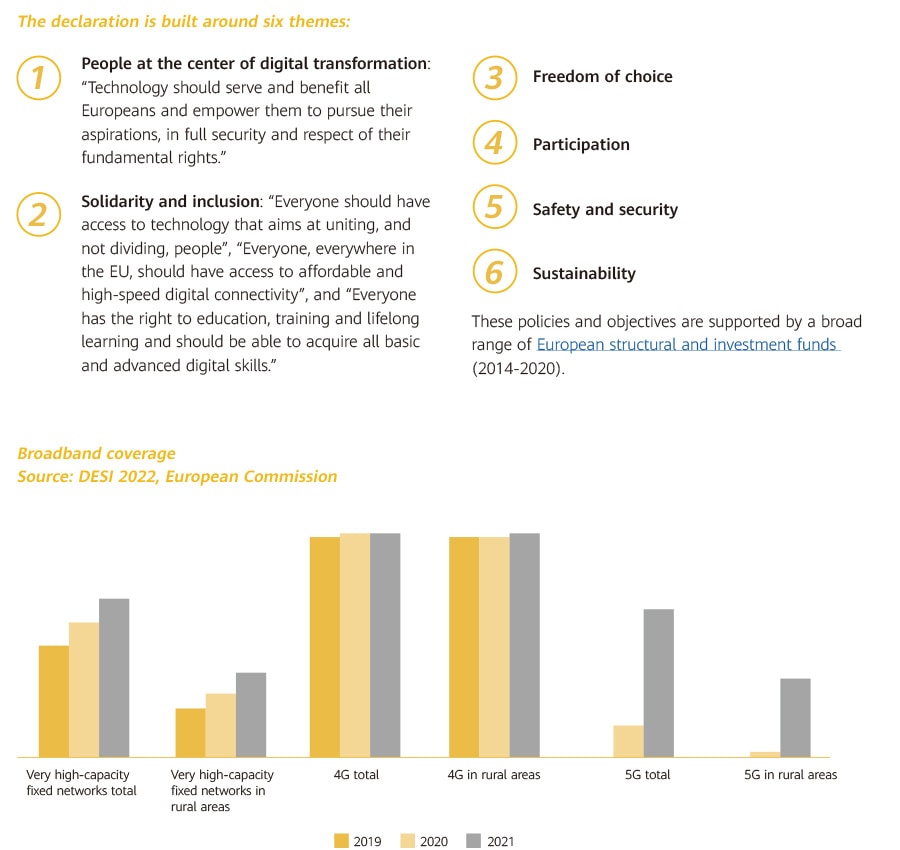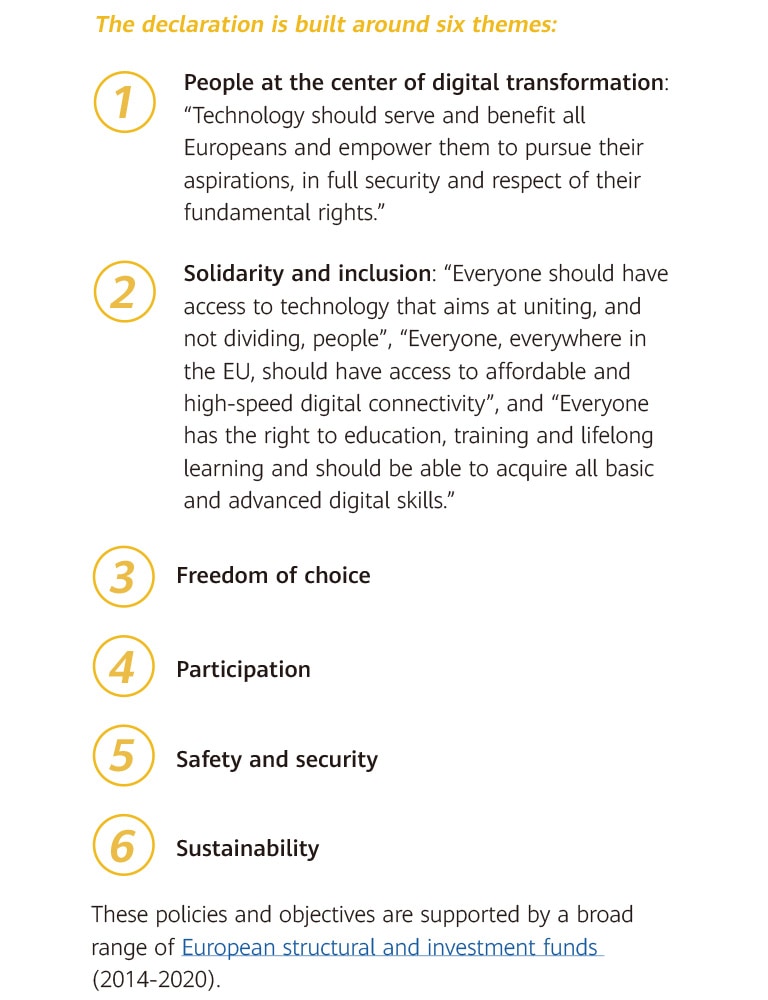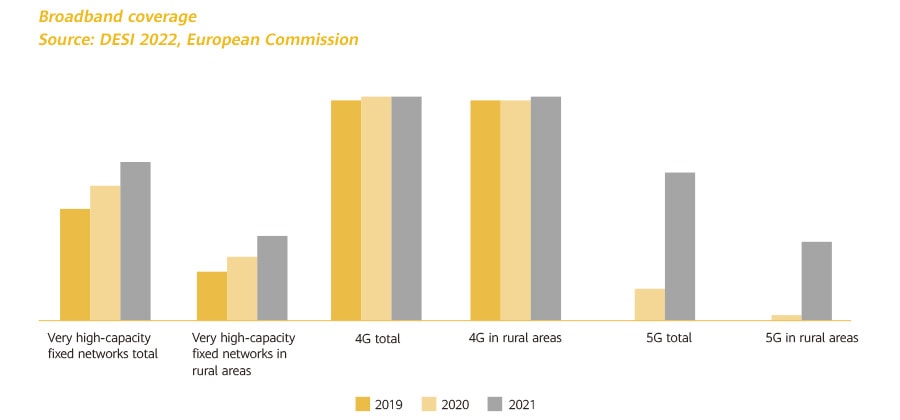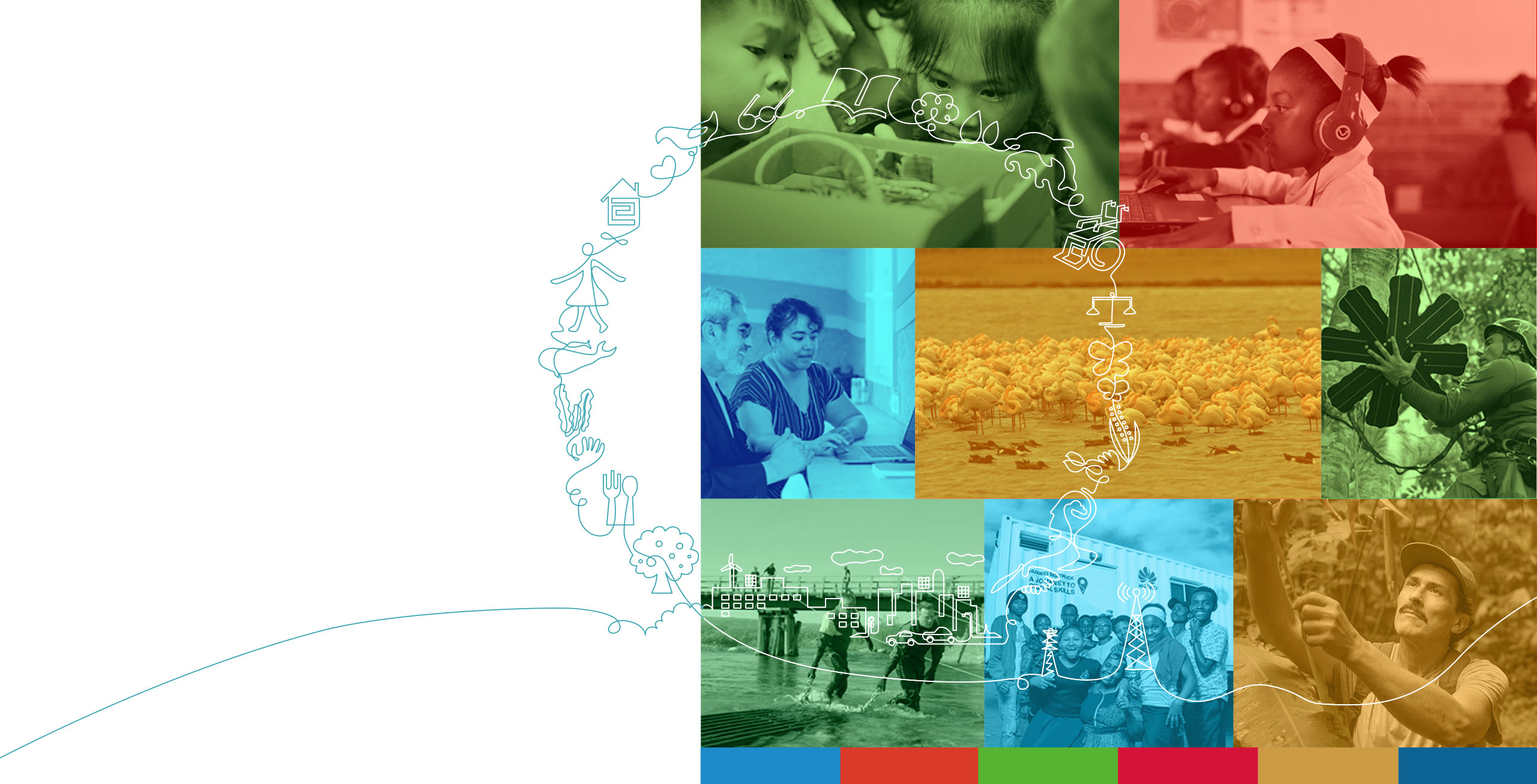
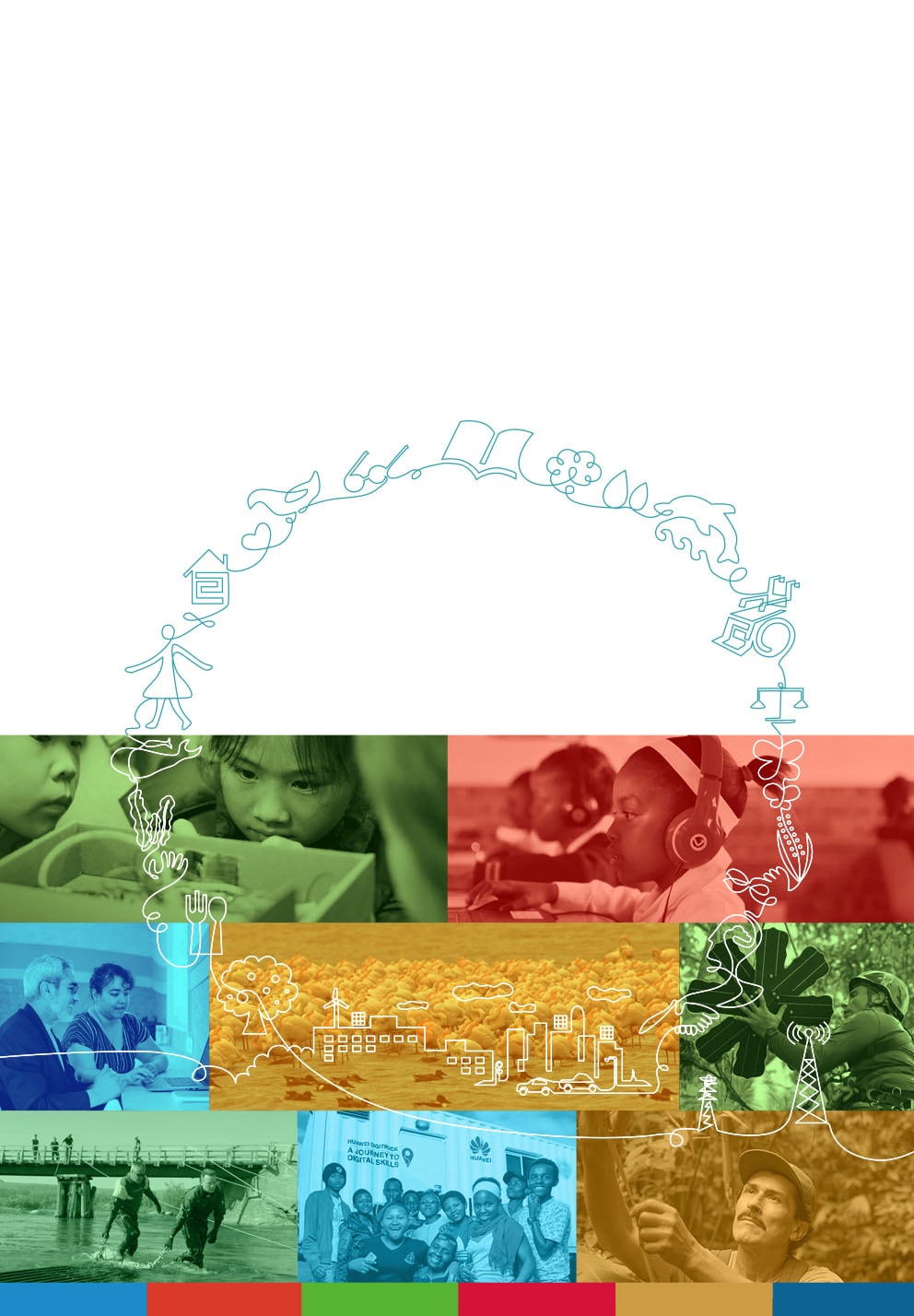
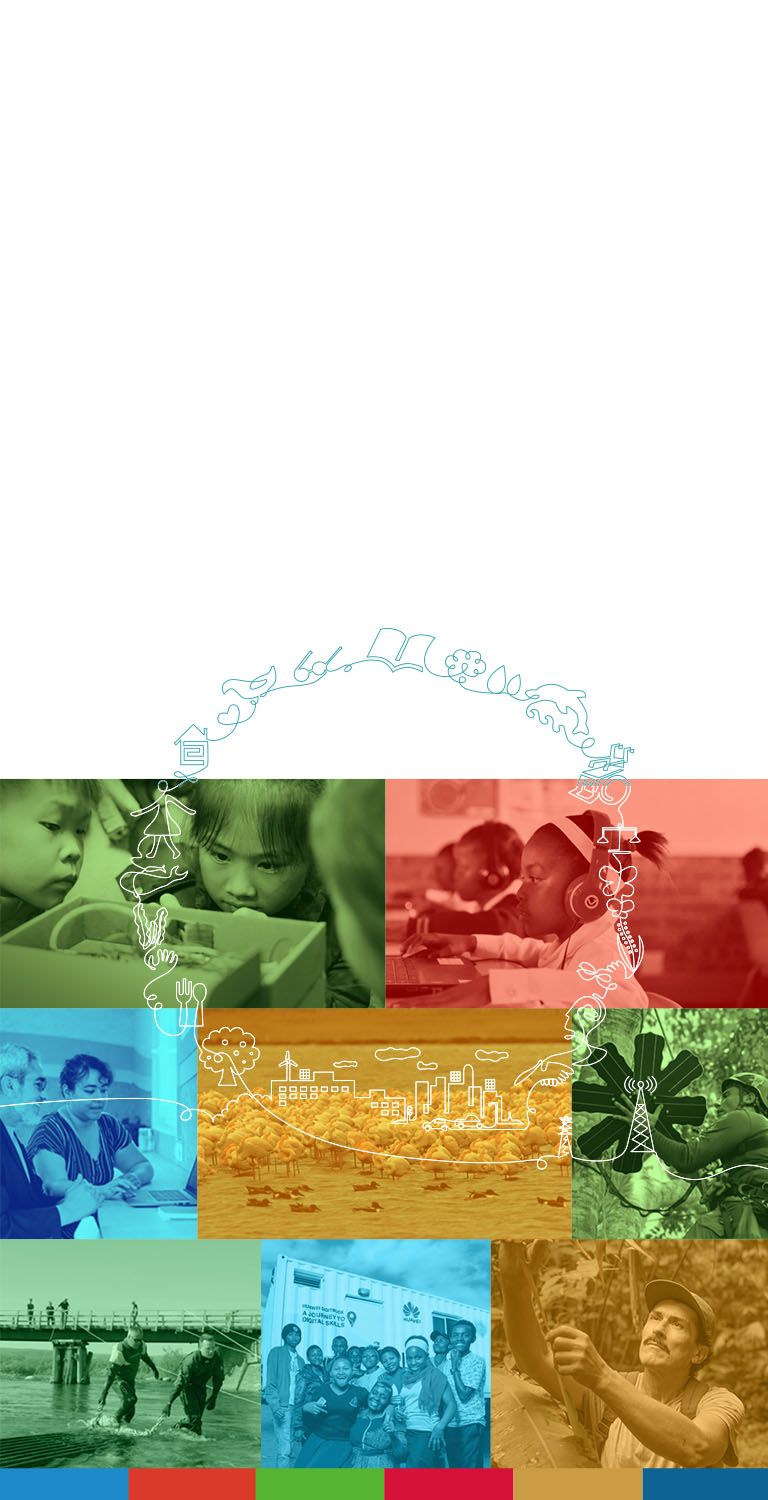
Digital Inclusion
Enabling an Inclusive and Sustainable Digital World
Enabling A More Inclusive and Sustainable Digital World
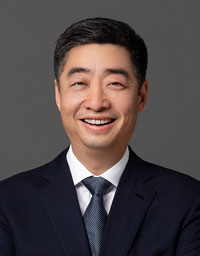 Ken Hu
Rotating Chairman,
Huawei Technologies
Ken Hu
Rotating Chairman,
Huawei Technologies
Digital technology is reshaping the world around us. While this transformation gains momentum, however, the digital divide is also expanding with staggering speed.
Right now, more than 2.7 billion people around the world have no Internet coverage. Among the five billion people who do, a significant portion only have very basic connections, and many lack the skills and resources to use them. Whether it's children without access to online education, elderly people who can't use smartphones, or young people who lack the digital skills to find jobs, an enormous segment of the population has been sidelined in a rapidly evolving digital world.
These challenges are further compounded by threats to our natural environment. Biodiversity loss, ecosystem degradation, and humanity’s expanding ecological footprint are adding up at an alarming pace. We already use more natural resources than the planet can sustainably regenerate, the equivalent of 1.75 earths, and the impact on both human well-being and biodiversity will be devastating if these trends continue.
We only have one planet, and it's changing. How can we protect the natural environment and ensure sustainable development while accounting for a society that is going digital – and fast? How can we make sure that everyone – and everything – has a place in this new digital world?
For us, the answer is clear: We have to use technology for good, and we have to use it for all forms of life.
Back in 2019, Huawei launched a digital inclusion initiative called TECH4ALL. Early on, we decided to focus on domains where we could make the most difference, such as education and environmental protection. The idea was that technologies like broadband, the Internet of Things (IoT), AI, and cloud could help power new applications in these domains, and through training and greater accessibility, we could help bring the benefits to more people – and to the environment.
To promote inclusion, we focus on equipping marginalized people with the skills and resources they need to make full use of digital technology in their everyday lives. In particular, we provide digital skills training for underserved groups, like people with disabilities, women, and remote communities, and we continuously enhance the accessibility of our products and services. To date, we have provided training for over 220,000 people around the globe, and more than 5.2 million people make use of the accessibility features on Huawei devices every month.
We also focus on connecting the unconnected. To help bring remote and rural communities into the digital fold, we designed a RuralStar solution that greatly reduces the cost and complexity of rural wireless network deployment. By 2025, we aim to connect 120 million people in remote communities across more than 80 countries.
As for sustainability, we're using digital technology to help protect the environment and enable more sustainable use of natural resources. Working together with environmental groups around the globe, we are exploring how we can more effectively use digital devices, networks, and cloud to enhance the monitoring and protection of fragile ecosystems.
The solutions we've developed are already helping rangers and conservationists do their work more safely and efficiently in protected areas across the Philippines, Mauritius, Mexico, and Italy. These programs are also helping ecologists protect endangered species, like Darwin’s foxes in Chile, Hainan gibbons in China, and whales and dolphins in Ireland. All told, TECH4ALL is boosting biodiversity conservation efforts in 46 protected areas around the world.
Our sustainability efforts extend to the digital world as well. To promote greater digital literacy and ensure sustainable development for individuals in the digital world, we provide a wide range of education solutions for children, the elderly, and unemployed youth. In countries like France and Kenya, we have converted shipping containers into mobile classrooms called DigiTrucks, which travel around the countryside to provide free training in basic digital skills. To date, these trucks have helped over 5,000 people improve their digital literacy and gain access to better work opportunities. In remote communities around China, we work with primary schools to provide students with hands-on, interactive STEAM curriculum through our DigiSchool program. As of today, over 2,500 young students have benefited from this program.
Digital technology and collaboration are key enablers for building a more inclusive and sustainable digital world. To achieve that goal, we invest heavily in the technology and platforms that enable the digital community to develop new and inventive applications. And of course, partnerships are everything. We work closely with governments, our customers, international organizations, research institutes, and all manner of NGOs to make the social value of digital technology as expansive and far-reaching as possible.
Huawei's vision and mission is to bring digital to every person, home, and organization for a fully connected, intelligent world. Together with our partners, we will keep innovating and expanding our efforts to make the digital world a more inclusive, sustainable space for all.

The Key Elements of Achieving Universal Digital Inclusion
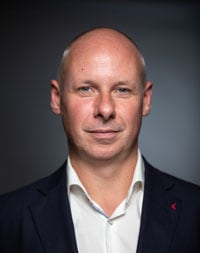 Derek O'Halloran
Head, Shaping the Future of Digital Economy & New Value Creation,
Member of Executive Committee, World Economic Forum
Derek O'Halloran
Head, Shaping the Future of Digital Economy & New Value Creation,
Member of Executive Committee, World Economic Forum
In 2019, an estimated 3.6 billion people – or 48% the global population – remained unconnected. As of October 2022, that number stands at 2.7 billion against a global population of 8 billion – or 34%.
This is tremendous progress, but with more than one third of the world’s population still unable to participate in the global economy, so much remains to be done.
The global COVID pandemic resulted in a surge of digital adoption that moved many aspects of our daily lives online. And it demonstrated that services such as healthcare, financial services, education, and support for SMEs and farmers can be delivered more broadly, more effectively, and more affordably when individuals and communities are digitally enabled.
However, not being able to use or afford digitally enabled services can leave individuals and families excluded from society and opportunity. Schools provided a prime example of this phenomenon during the pandemic. Public education systems with pre-existing knowledge and experience of running distance and multimodal learning delivery mechanisms fared significantly better than in-person systems.
For vulnerable individuals and communities, a lack of key infrastructure and compatible devices, unaffordable data packages, and a lack of basic skills needed to use the Internet are key challenges that require long-term solutions.
Building economically sustainable, inclusive, and affordable digital service ecosystems to overcome these challenges is a team sport that requires multi-sector partnerships across technology providers, operators, government, investors, and the industries providing life services.
Initiatives such as the World Economic Forum’s EDISON Alliance, a global movement of over 100 organizations from the public and private sector, including Huawei, are committed to prioritizing digital inclusion as foundational to the achievement of the UN Sustainable Development Goals (SDGs) so that every person can affordably participate in the digital economy.
It includes a global cross-sector ecosystem of like-minded organizations to tap into for the partnerships needed to be successful, and to learn from peers. The community actively seeks to highlight and accelerate the most successful and promising initiatives for others to support.
Mobilizing public-private collaboration is crucial to bridge the financing, regulatory, and policy gaps to reach universal broadband access within the next decade. With greater access and more affordable digital services, we can stop the widening of existing divides and ensure that the other half of the world gets connected.
For the world to build back better, governments must embed digital within all other national priorities and set up horizontal and whole-of- government approaches to facilitate the necessary policies, regulatory, and economic environment to connect the unconnected while also progressing toward the achievement of the SDGs.
The result will be the growth of new markets for business and greater opportunity for individuals and communities, underpinned by affordable connectivity and devices and the digital skills that can drive participation in the digital economy.
Universal digital inclusion is sometimes referred to as the 18th SDG. With leadership, focus, and collaboration, we have collectively demonstrated that universal Internet adoption is a solvable challenge – a challenge that we believe can be overcome by 2030.


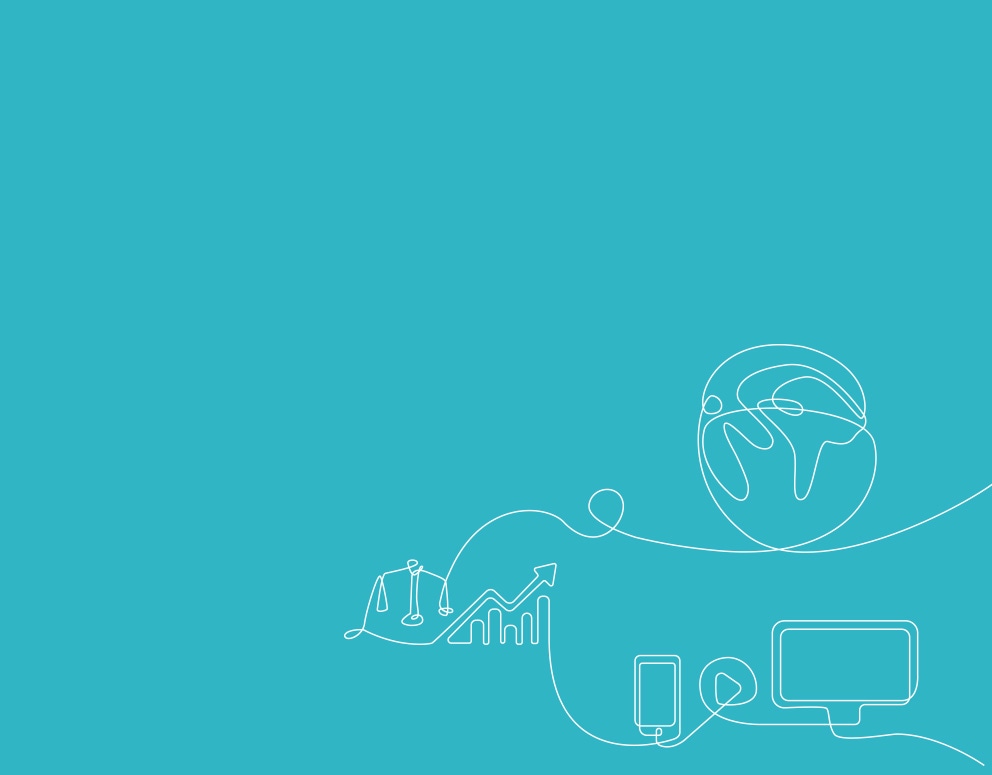
Insights
Digital Inclusion: The Key to Unlocking Digital Potential in the African Union
One of the seven aspirations of Africa’s Agenda 2063 is to build a prosperous Africa based on inclusive growth and sustainable development. The continent’s digital transformation can achieve that goal based on six priority sectors set by the African Union: industry, trade, financial services, government, education, health, and agriculture. The strategy is built on existing frameworks and initiatives and is designed to create an empowered and skilled population.
In the era of the fourth industrial revolution, a time of emerging digital technologies, the African continent is realizing the need to harness the potential that exists in all sectors of life.
The African Union believes that digital transformation is a driving force for innovative, inclusive, and sustainable growth. And through the African Union, the continent has adopted a digital transformation strategy that prioritizes digitally enabled socioeconomic development.
Africa has many opportunities ahead thanks to its youthful population structure. Innovation and digitalization can stimulate job creation and contribute to addressing poverty, reducing inequality, facilitating the delivery of goods and services, and contributing to the achievement of Agenda 2063 and the UN Sustainable Development Goals. Despite the technology challenges and gaps that still exist in the continent, African countries are well-positioned for a comprehensive digital transformation strategy that can guide a common and coordinated response to reap the benefits offered by the fourth industrial revolution.
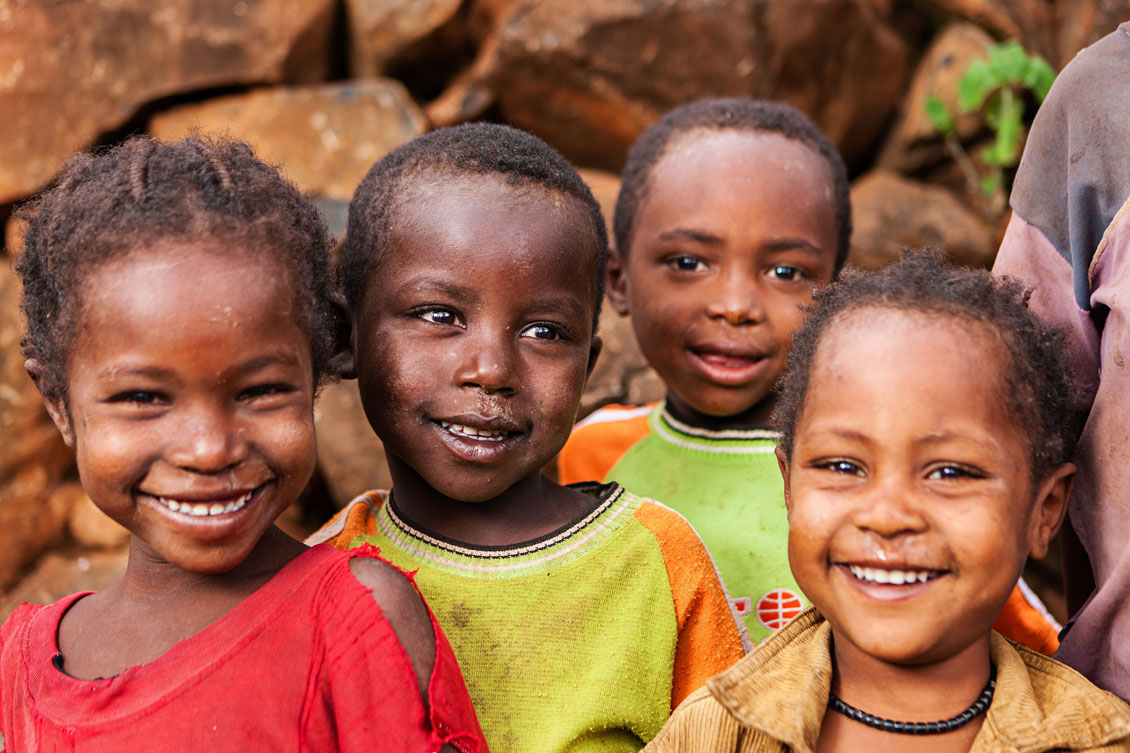
Key strategies, initiatives, and frameworks
The Digital Transformation Strategy for Africa builds on existing initiatives and frameworks such as the Policy and Regulatory Initiative for Digital Africa (PRIDA), the Programme for Infrastructure Development in Africa (PIDA), the African Continental Free Trade Area (AfCFTA), the African Union Financial Institutions (AUFIs), the Single African Air Transport Market (SAATM), and the Free Movement of Persons (FMP). These can support the development of a Digital Single Market (DSM) for Africa as part of the African Union’s integration priorities.
The African Union has based the Digital Transformation Strategy for Africa on a series of foundational pillars that include Enabling Environment, Policy and Regulation, Digital Infrastructure, Digital Skills and Human Capacity, and Digital Innovation and Entrepreneurship.
The African Union is working to promote policies and regulations that address emerging technologies in terms of how best to protect citizens, ensure fair markets, and enforce regulations while allowing new technologies and business to thrive. To achieve this, certain areas of improvement, including rethinking regulatory approaches and adopting models that are agile, iterative, and collaborative, need to be addressed. This can help face the challenges posed by emerging technologies and the fourth industrial revolution. Moreover, developing policies that address the spectrum issues around emerging technologies can help formulate strategies for 5G and AI and, in particular, devices for the Internet of Things.
To reach digital transformation goals in critical sectors, the African Union is considering digital initiatives at the national and regional levels by working hand-in-hand with member states and Regional Economic Communities (RECs). Some countries are already at a key stage of digitalizing the vital services that people need most, including e-commerce, e-Health, e-Agriculture, and e-Governance.
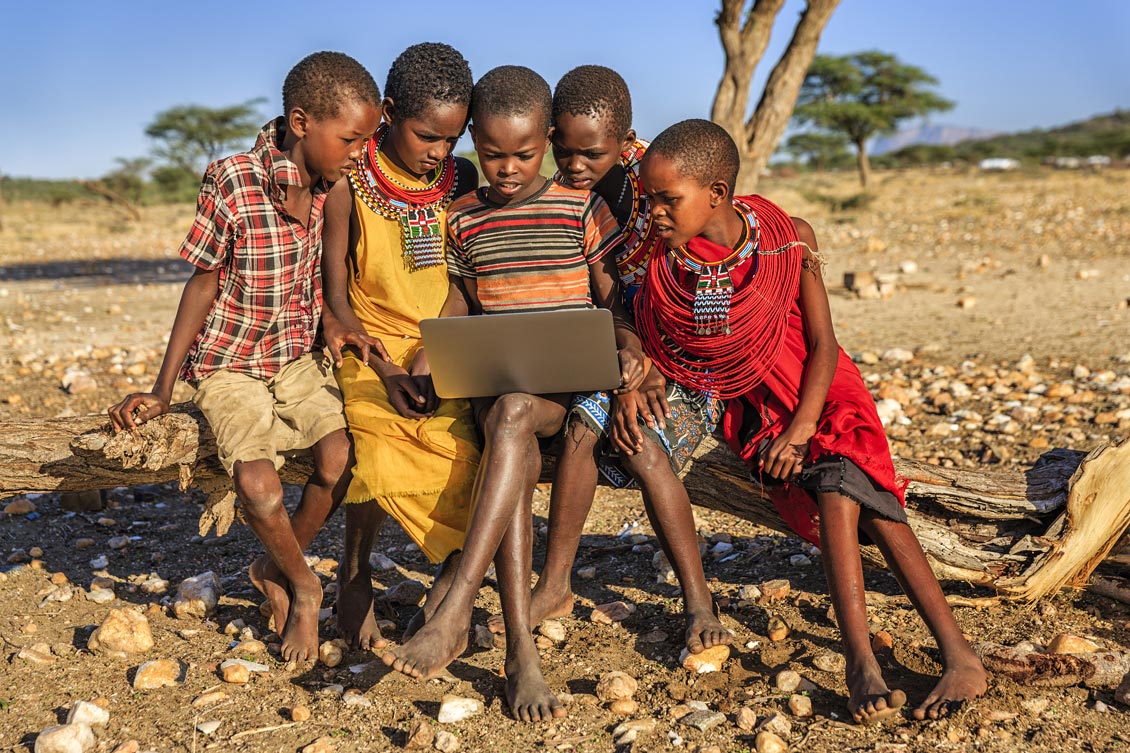
Africa’s most precious asset – its young people, who constitute more than 60% of the overall population – can be empowered and transformed into a digitally adaptive, skilled, and innovative workforce.
Digital skills power a digital future
Another fundamental issue involves building digital skills and thus the human capacity for digital transformation to be viable. A digital skills gap exists in Africa, exacerbated by the fact that African countries are also struggling to keep and use locally trained people at the national level. This gap also widens when the gender gap is factored in. Thus, a key strategic approach is to ensure the widespread availability of digital skills that allow individuals and businesses to harness today’s opportunities and guard against the risks associated with not participating in the digital economy.
There is also a need to meet some preconditions for Africa to achieve digital transformation and emerge as a globally competitive continent. The main one is investing in and cultivating highly skilled people as the producers, consumers, and innovators of digital technologies. Underpinned by both technological and human capacities, investing in the digital capabilities of citizens offers the most robust strategy for the future. What is also necessary is a critical mass of a skilled workforce that can master and apply emerging technological advancements and their sophisticated integration into every aspect of social, economic, and political systems. Similarly, as active participants in the digital ecosystem, citizens must possess the digital capabilities to embrace and enable advancement in their daily lives.
Africa’s most precious asset – its young people, who constitute more than 60% of the overall population – can be empowered and transformed into a digitally adaptive, skilled, and innovative workforce.
Emerging technologies require measures to continue building the digital skills of people, not just as consumers but also as citizens. The supreme currency in the digital age is people and their skills. With an appropriate and coordinated development strategy for human and institutional capacity, Africa’s most precious asset – its young people, who constitute more than 60% of the overall population – can be empowered and transformed into a digitally adaptive, skilled, and innovative workforce. This workforce would not only comprehend, adopt, and move with global trends, but also chart its own digital pathways towards inclusive growth and development.
New pathways with new sources of job creation are possible in this age of technological change.
To address challenges and transition to a prosperous digital future, Africa partners with tech giants around the world, such as Huawei, to harness know-how and help drive digital transformation. Huawei has been a reliable partner in contributing to capacity building in the African Union through its Seeds for the Future program and MOU that covers critical sectors, such as the Pan-African University, to supply the continent with qualified young people in the ICT field.
It is clear that inclusive education, bridging educational gaps, and cultivating a skilled population taken from the African population – the youth, men, and women of the continent – will surely lead Africa to the vision of an integrated, prosperous, and peaceful continent, driven by its own citizens and representing a dynamic force in the international arena.
Developing Teachers' Skills for Digital Learning and Education in the Caribbean
The pandemic forced many schools in the Caribbean to quickly transition to online education when they were not ready to. It also prompted action to integrate digital technologies and rethink learning and teaching paradigms to drive up education resilience and continuity in the region.
1.5 billion
students and youth affected by COVID-19Findings from a survey conducted in the Caribbean region revealed that mainstreaming ICT in Education has been a central issue for over a decade. During this time, most governments drafted or approved ICT policies in Education, although with limited impact on practice. Funding, hardware quality, and maintenance were identified as critical challenges to leverage ICT to improve quality in Education. On the other hand, most secondary and many primary schools enabled teachers and students to access computers and Internet access was, in many cases, adequate to meet needs. Despite these developments, digital technologies have failed to consistently deliver the promise of facilitating a more flexible, inclusive, and equitable education for all.
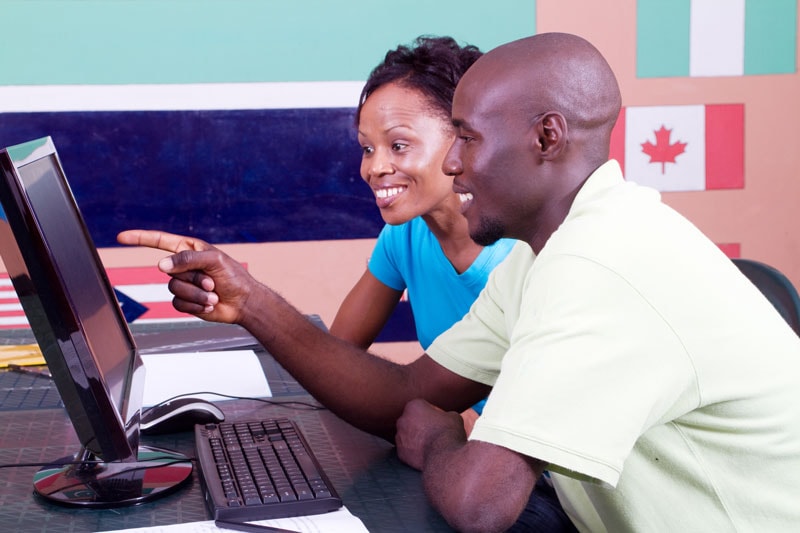
According to UNESCO, COVID-19 caused a historic disruption to education worldwide, affecting more than 1.5 billion students and youth, with the most vulnerable learners hit the hardest. In the Caribbean, many schools were forced to quickly transition to online education without adequate infrastructure, tools, and resources. At the same time, many teachers found themselves unprepared to face the challenges of teaching in virtual learning environments and embracing hybrid modalities. Nevertheless, the pandemic has been an opportunity to highlight the persisting digital gaps and the need to rethink the role of digital technologies in education agendas, especially in light of their critical role in shaping the future of Caribbean societies.
Based on the previous context, UNESCO has established a partnership with GIZ, Blackboard, and the University of West Indies to strengthen the pedagogical and technological skills of Caribbean teachers through an initiative called Distance learning and Teacher Training Strategies in the Caribbean SIDS. The project was funded by the German Federal Ministry for Economic Cooperation and Development (BMZ) and supported by UNICEF Jamaica, aiming to strengthen teachers' capacities to engage in innovative, technology-supported teaching methods for blended learning and online teaching strategies.The project builds on the experience of a previous pilot initiative to strengthen the capacities of teacher trainers, teachers, and education leaders in digital literacy and blended learning solutions.
40
Master Trainers from the English and Dutch Caribbean were trained in online pedagogies.200
teachers from K-12 schools received training on ICT.The training of teachers had four phases:
i) designing the course;
ii) developing course materials;
iii)implementing the course; and
iv) evaluating the implementation of the course.
Implementation strategy
The project covered English- and Dutch-speaking Caribbean Small Island Developing States (SIDS), including the following UNESCO Member States and Associated Members in the Caribbean: Antigua and Barbuda, The Bahamas, Barbados, Belize, Cayman Islands, Dominica, Grenada, Guyana, Jamaica, Montserrat, Saint Kitts and Nevis, Saint Lucia, Saint Vincent and the Grenadines, Suriname, Trinidad, and Tobago, Anguilla, Aruba, British Virgin Islands, Curaçao, and Saint Maarten.
40
Master Trainers from the English and Dutch Caribbean were trained in online pedagogies.200
teachers from K-12 schools received training on ICT.A two-tiered cascade approach was adopted for the project. The first stage was devoted to training 40 Master Trainers from the English and Dutch Caribbean in online pedagogies and how to facilitate a four-week distance training course. The University of West Indies facilitated the training, and upon successful completion, participants received certificates for Core Master Trainers for Online and Blended Teaching. During the second stage, a group of up to 200 teachers from K-12 schools received training to acquire or upgrade their ICT (digital or pedagogic) skills. The training focused mainly on applying innovative teaching methods or adaptive pedagogies in remote, hybrid, or blended classrooms.
The training of teachers had four phases:
i) designing the course;
ii) developing course materials;
iii)implementing the course; and
iv) evaluating the implementation of the course.
The training of teachers had four phases: i) designing the course; ii) developing course materials; iii) implementing the course; and iv) evaluating the implementation of the course. The main topics covered during the training were online pedagogy and methods for working with a diversity of students online, including the creation, selection, and use of a variety of digital tools such as videos and interactive platforms, web conferencing, online task creation and quizzes, and the selection of high quality online educational resources.
51
master trainers have been certified to train teachers in technology-supported teaching methods for blended learning and online teaching strategies.Main results
Since the inception of the pilot project, a total of 51 master trainers have been certified to train others to engage in innovative, technology-supported teaching methods for blended learning and online teaching strategies. The four-week distance training course has trained over 5,000 teachers in the first two cohorts and over 7,000 in the third cohort. A total of 12,819 teachers have been enrolled across 20 SIDS countries.

12,819
teachers have enrolled for the training in20
SIDS countriesChallenges, opportunities, and lessons learned
Several challenges and opportunities were identified during the implementation of the project that are important lessons for future initiatives aiming to develop and strengthen teachers' skills for online learning and education.
a) Equipment and connectivity: Many teachers participating in the training had no access to proper digital devices or high-quality Internet provision. Future projects targeting teachers' digital skills for online learning and education will need to assess their needs in terms of equipment and connectivity. Based on the identified needs, appropriate strategies involving the government and industry will be required to ensure sustainable conditions for digital skills development.
b) Online teaching/learning as a paradigm shift: The development of virtual learning environments introduced a dramatic paradigm shift in education. As most teachers do not have prior experience teaching or learning in online environments, they tend to reproduce in-person teaching practices in online settings, resulting in frustration and lower performance. For this reason, an assessment of prior experience and an induction process are essential to successfully promote the change in mindset required to transition to online teaching.
c) Quality of interaction and engagement: Online environments offer fewer opportunities for the interaction and engagement of students and teachers. Future training programs will need to provide teachers with strategies to help them make up for this shortcoming and create alternative ways to support learning, identify students' difficulties, and engage with those who have problems.
d) Supporting students with special needs: Teachers assisting students with special education needs, such as autism and dyslexia, are particularly challenged by online environments because of the close relationship between student and teacher in these cases. Future training opportunities will need to build the capacities of teachers to maintain the pedagogic quality of these relationships in online settings.
e) Flexible and quality course design: As assessed by participants, one of the substantial aspects of the course was the possibility to adjust different elements to accommodate participants' needs and local school contexts. This flexibility was experienced as options to download materials when the Internet was not available or as different levels of certification to cater to the diversity of participants' digital skills. Furthermore, the course contained several elements that raised the quality of the teaching and learning experience such as time for collaboration, reflection, and experimentation, an intuitive design, and various teaching and assessment tools.
f) Focus on online tools and pedagogies: Teachers particularly valued the practical guidance on using synchronous and asynchronous approaches and various tools for different subject matters. Other positive aspects to consider in future projects are online class management principles and student motivation strategies.
g) Supporting master teachers: The continuous support provided to master teachers through weekly meetings and mentorship sessions with experts in online and blended learning was critical to success. Furthermore, the community of practice established with all master teachers allowed quick communication with one another to share ideas, challenges, and suggestions to address them, and should be replicated in future projects.
h) Strengthening synergies and collaboration: The success of this project relied on the strengths, technical expertise, and willingness to engage in a collaborative effort by institutions from government, academia, the private sector, and international cooperation. In a context like the Caribbean region, which is marked by a confluence of multiple organizations promoting digital learning and education, aligning agendas and building synergies will be critical measures to ensure a more significant impact of future projects.
The successful integration of digital technologies into teaching and learning requires rethinking the role of teachers and reforming their preparation and professional development.
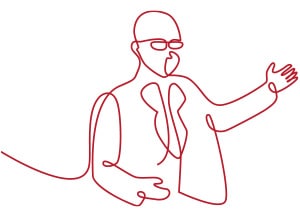

Final considerations
Teachers are major agents for the transformation of education in the Caribbean region. For this reason, the successful integration of digital technologies into teaching and learning requires rethinking the role of teachers and reforming their preparation and professional development. Building upon the results and lessons learned in this project, UNESCO will continue seeking synergies and strategic partnerships with universities, private companies, governments, and other organizations, to provide teachers with system-wide support for the educational use of digital technologies, to promote teacher innovation, and to develop networks and platforms that allow teachers to share experiences and approaches that may be of service to peers and other stakeholders.
Strategies and Initiatives for Addressing Three Levels of Digital Divide in the EU
Since the full liberalization of European telecommunications markets on January 1, 1998, competition has been the main driver of affordability and thus a pillar of inclusion. The regulatory framework has directed national regulatory authorities to promote competition and ensure that users, including people with disabilities, older users, and those with specific social needs, derive maximum benefit in terms of choice, price, and quality.
The liberalization of the telecoms sector
After the European Commission concluded in favor of fully liberalizing the telecommunications sector in 1992, and in light of subsequent political agreements in 1992 and 1993, the European Council, European Parliament, Economic and Social Committee, and Committee of the Regions recognized that liberalization requires a harmonized regulatory framework that enables universal service.
In 2010, the European Commission stipulated in the communication “A Digital Agenda for Europe” that the benefits of digital society should be available to all. The European Commission began exploring the role of universal service in achieving broadband for all and, in 2018, integrated this goal into the European Electronic Communications Code (EECC). While reiterating the crucial role of competition, the amendment also includes the new objective of not just providing connectivity and access via very high-capacity networks, but also of take-up by all citizens and businesses in the Union.
The emergence of broadband connectivity has enabled the development of e-commerce, a myriad of Internet-based content, applications and services, and the digitalization of the European economy. More companies and public services are transitioning from traditional services to online services, and schools and universities are digitalizing their offerings and learning processes.
Boosted by shorter development cycles, digital technologies are changing people’s lives.

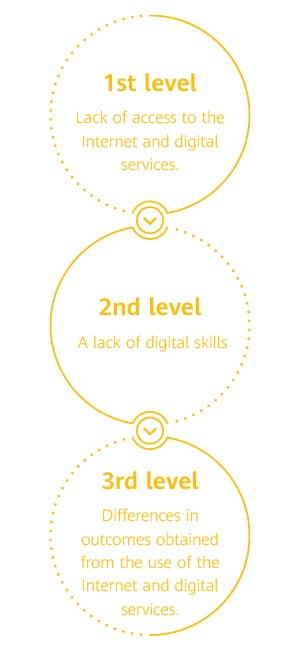
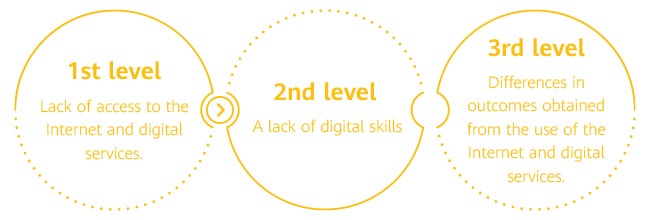
The three levels of digital divide
However, the proliferation of digital technologies has revealed a digital divide that threatens social cohesion with far-reaching social, economic, and political implications. In 2010, the European Commission identified that a lack of digital literacy and skills was excluding many citizens from the emerging digital society and economy. Furthermore, a study commissioned by the Body of European Regulators for Electronic Communications (BEREC) on post-COVID measures to close the digital divide concludes that the concept of the digital divide comprises three different levels:
- First level: lack of access to internet Internet and digital services.
- Second level: lack of digital skills
- Third level: differences in the outcomes obtained from the use of the Internet and digital services.
As a regulatory framework alone cannot overcome the digital divide, the European Commission launched several initiatives and fixed objectives in 2010, including the 10-year digital agenda for Europe.
Of course, a robust target must be underpinned by regular measurements of progress. To this end, the European Commission monitors digital development in the EU’s 27 member states through the Digital Economy and Society Index (DESI), a multidimensional report that covers four main policy areas: Human Capital, Connectivity, Digital Technology Integration, and Digital Public Services.
DESI also includes country profiles, which help member states identify priority areas for action.
The European Commission identified that a lack of digital literacy and skills was excluding many citizens from the emerging digital society and economy.

70%
of adults to have basic digital skills by 2025Human Capital
The "Human Capital " dimension comprises seven indicators.
Three are expressed as the percentage of individuals that possess basic digital skills, intermediate digital skills, and basic digital content creation skills. They monitor the performance of member states in reaching skill targets, provide useful information on citizens’ online behaviors, and give insights into people’s skills and competences in different digital domains.
ICT specialists (4.3% in 2021 versus 3.8% in 2018) and female ICT specialists (19% in 2021 versus 17% in 2018) are expressed as the percentage of individuals in employment and as a percentage of ICT specialists, respectively. Enterprises that provide ICT training (20% in 2020 versus 22% in 2018) are expressed as a percentage of total enterprises and ICT graduates (3.8% in 2018) as a percentage of total graduates.
The European Commission identified that a lack of digital literacy and skills was excluding many citizens from the emerging digital society and economy.

70%
of adults to have basic digital skills by 2025Since 2015, the European Commission has measured citizens’ digital skills through the Digital Skills Indicator (DSI). Today, 54% of Europeans have at least basic digital skills. However, this is 26 percentage points below the target, with marked differences between countries. To close the gap, the EC set targets in the European skills agenda and the digital education action plan to ensure that 70% of adults have basic digital skills by 2025, and to reduce the underperforming level of 13-14 year-olds in computing and digital literacy from 30% (2019) to 15% by 2030.

94%
subscription rate to an Internet access service in cities (2021)
92%
subscription rate to an Internet access service in towns and suburbs (2021)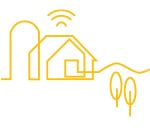
89%
subscription rate to an Internet access service in rural areas (2021)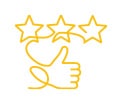 Technology that works for the people
Technology that works for the people
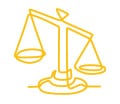 A fair and competitive digital economy
A fair and competitive digital economy
 An open, democratic, and sustainable society
An open, democratic, and sustainable society
Connectivity
For fixed and mobile broadband, the "Connectivity" dimension covers both demand (take up) and supply (coverage). On the demand side, it assesses the take up of fixed broadband between 100 Mbit/s to 1 Gbit/s and the take up rate of mobile broadband. On the supply side, it assesses the coverage of very high-capacity fixed networks, the population covered by 5G networks, and the assignment of radio spectrum for 5G. It also records the retail prices of fixed and mobile offers (i.e., price plans) and converged bundles that comprise elements of fixed and mobile services.
In 2021, 92% of households in the European Union had subscribed to an Internet access service. However, the urban-rural divide in Internet usage persists. Households in cities and suburbs have comparatively higher subscription rates at 94% in cities and 92% in towns and suburbs, while the rate in rural areas is slightly lower at 89%.

94%
subscription rate to an Internet access service in cities (2021)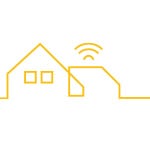
92%
subscription rate to an Internet access service in towns and suburbs (2021)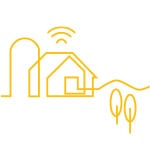
89%
subscription rate to an Internet access service in rural areas (2021)Very high-capacity fixed networks covered 70% of European households in 2021, up from 60% in 2020. For mobile technologies, 4G coverage in populated areas is almost universal at 99.8%, while 5G coverage jumped from 14% of populated areas in 2020 to 66% in 2021. However, despite progress, broadband coverage remains uneven between rural and urban areas, with large differences especially apparent in very high-capacity networks.
A digital decade
Spanning the decade from 2020 to 2030, the European Commission is implementing a series of new initiatives and has set more ambitious targets.
 Technology that works for the people
Technology that works for the people
 A fair and competitive digital economy
A fair and competitive digital economy
 An open, democratic, and sustainable society
An open, democratic, and sustainable society
On February 19, 2020, the European Commission issued the communication “Shaping Europe’s Digital Future”, re-affirming that digital transition should work for all and open up new opportunities for business. The communication presents three main pillars supporting the European approach: (i) technology that works for the people, (ii) a fair and competitive digital economy, and (iii) an open, democratic, and sustainable society.
Furthermore, on March 9, 2021, the European Commission presented its vision, targets, and avenues for achieving the successful digital transformation of Europe by 2030, proposing the Digital Compass strategy for the EU's digital decade. Digital Compass centers on four main areas:
- A digitally skilled population and highly skilled digital professionals: aims to achieve 20 million employed ICT specialists and an equal ratio of women and men with digital skills by 2030. This complements the European Pillar of Social Rights Action Plan, which aims for 80% of adults possessing at least basic digital skills by 2030.
- Secure and performance-sustainable digital infrastructures: aims to cover all European households with Gigabit networks and all populated areas with 5G networks by 2030. It also includes targets for cutting-edge semiconductors; data, edge, and cloud build-out; and quantum computing.
- Digital transformation of businesses: aims to drive the uptake of cloud computing services, big data, and AI, with innovators scaling up and late-adopter SMEs reaching a basic level of digital intensity.
- Digitalization of public services: sets targets for the online availability of key public services, e-health, and digital IDs.
Additionally, on September 15, 2021, the EC proposed the “2030 Policy Programme: Path to the Digital Decade”, which introduces a structured monitoring and collaboration process between the Commission and member states, with the European Parliament supporting the achievement of common objectives and targets for Europe's digital transformation as set out in the 2030 Digital Compass.
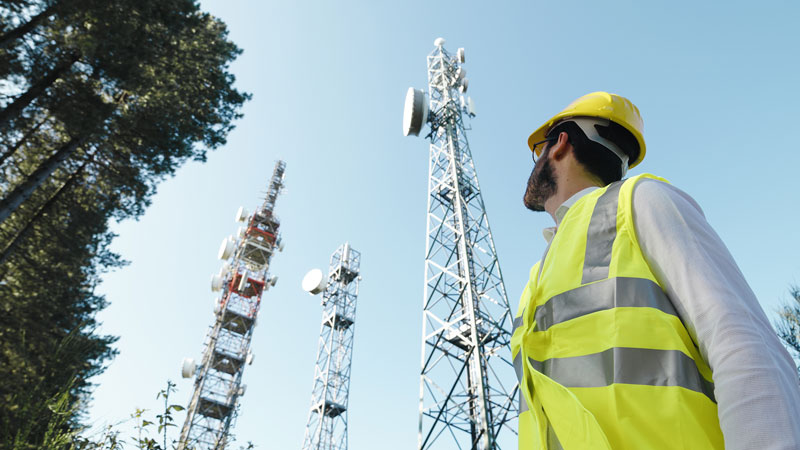
People-centric digital transformation
To ensure that no one is left behind, the European Commission presented a draft declaration on digital rights and principles for people-centric digital transformation on January 26, 2022.
Key takeaways
In view of the rapid digitalization of society and the constant evolution of digital technologies, ensuring that no one is left behind in the digital economy has become a bigger challenge than ever. Fighting the digital divide requires a comprehensive approach that includes fostering digital skills, but also addresses the need to strengthen digital infrastructure and enable the digital transformation of businesses and public services.
Moreover, the concept of the digital divide must be considered to be multilevel, spanning access to the Internet and digital services, digital skills, and outcomes from accessing the Internet and digital skills.
Ensuring that markets are competitive is not just a prerequisite or an enabler of business and the digitalization of public services, it is also the best approach for addressing the first level of the digital divide – access to the Internet and digital services. It is an approach that should be complemented by universal service provisions and state support for network deployment in areas that would otherwise not be served by private investments, while assuring that competing operators are entitled to deliver services over publicly funded networks.
Closing the second and third levels of the digital divide – digital skills and outcomes – is more complex and necessitates cooperation between European institutions, member states, local authorities, the private sector, and civil society.
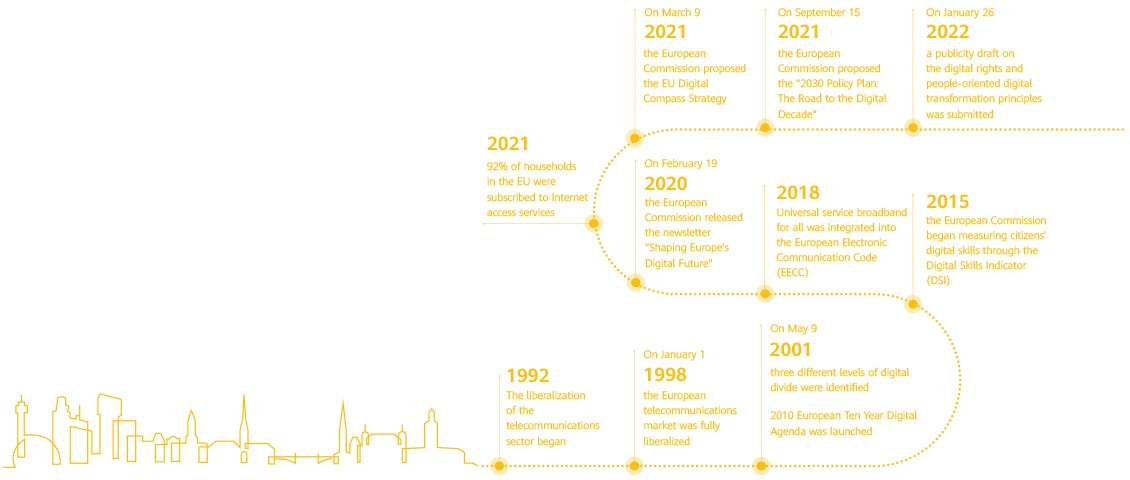
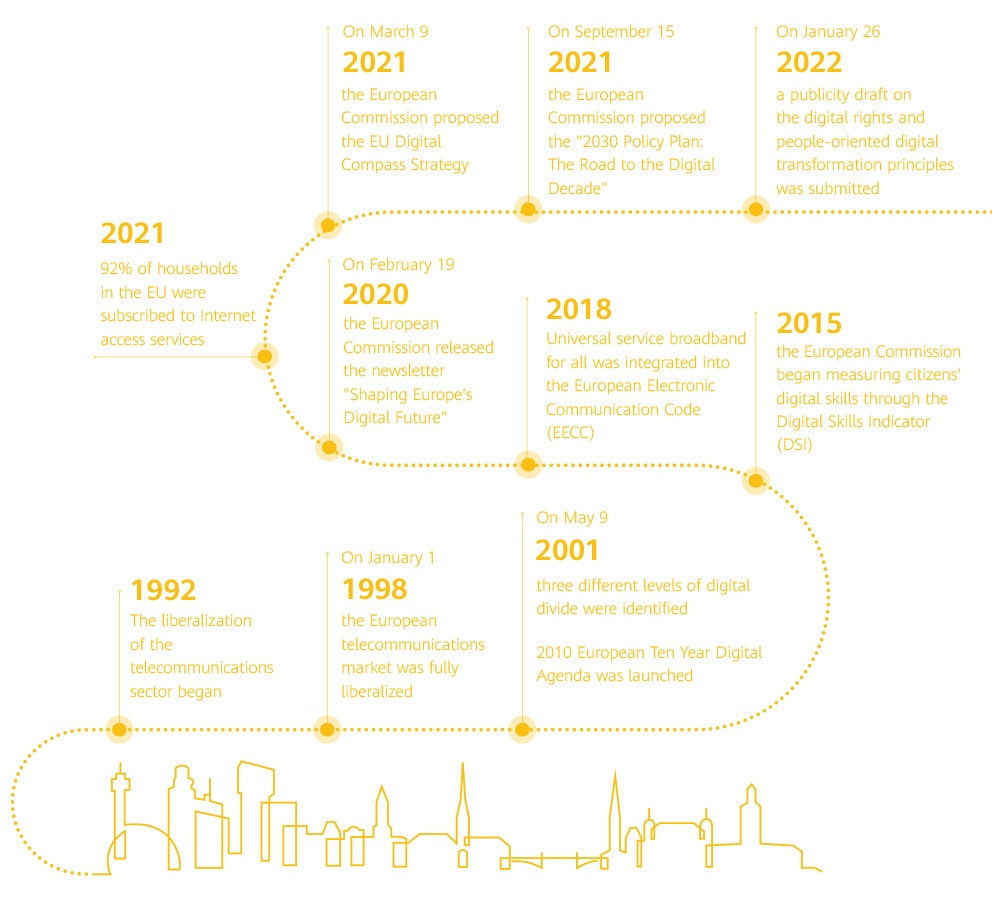


Technology in Focus
Scaling Up Biodiversity Monitoring with AI and Cloud
The increased accessibility of artificial intelligence and the increased processing capabilities of cloud-based solutions are making biodiversity monitoring significantly more inclusive for individuals and organizations across the world.
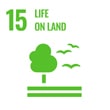
Gaining a deeper understanding of the natural world around us through biodiversity monitoring is crucial to understanding where and how to protect our rich ecosystems and the species that inhabit them.
Biodiversity studies have traditionally required significant investment in special-purpose technologies for data collection and highly skilled, experienced conservation scientists for analysis and insights. A comprehensive survey of the scientific literature in 2018 found that 58% of acoustic biodiversity studies were based solely on experts manually identifying the presence of species from raw data.
Artificial intelligence is beginning to play a crucial role in scaling up the number of studies that scientists can perform and the amount of data that can be analyzed in each study. However, it is even more transformative that the same technology is opening up biodiversity studies to a much wider audience, to people and organizations in less developed regions and those on the periphery of scientific communities.
Crucially for the future of biodiversity, it can support and empower people on the ground who are most likely to act.
As a result, the increased accessibility of artificial intelligence and the increased processing capabilities of cloud-based solutions are making biodiversity monitoring significantly more inclusive to individuals and organizations across the world.
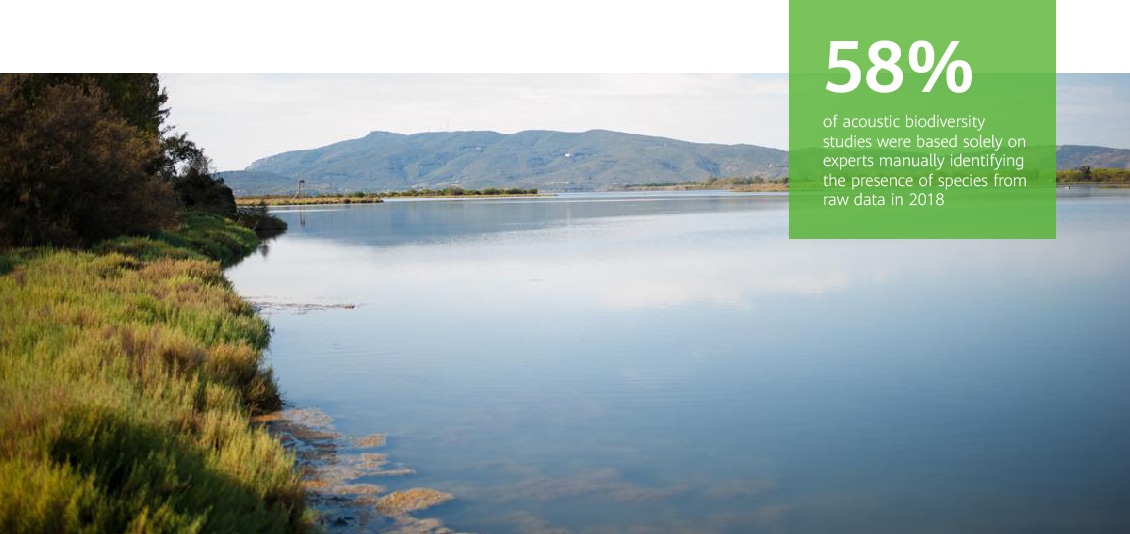
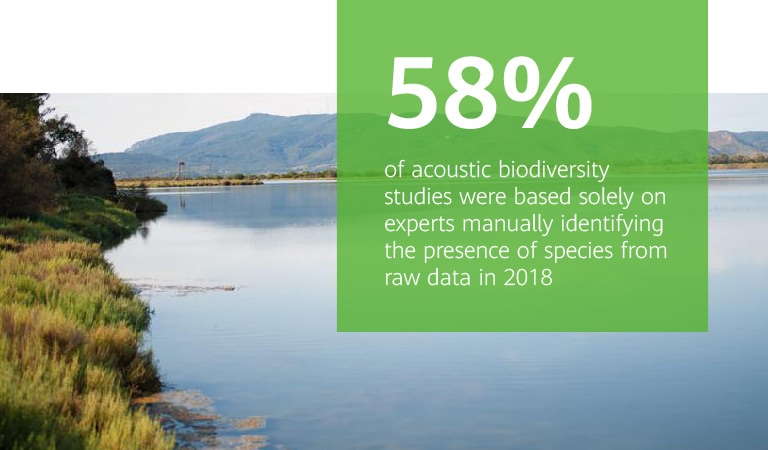
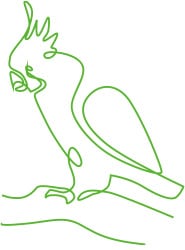 The Arbimon platform now contains examples of over
The Arbimon platform now contains examples of over
2,000
different bird calls, representing more than20%
of the world’s bird species.Arbimon: Smart, open, and free
Rainforest Connection has developed Arbimon, an open and free-to-use platform that provides an end-to-end solution for acoustic biodiversity monitoring and insights. At the foundation of Arbimon is a core technology layer responsible for managing audio files and project data in the cloud, which has enabled thousands of users to create more than 2,900 projects across 114 countries. On top of this core layer are AI tools for automatically identifying and validating the presence of vocal species from the raw audio data. The latest feature of the Arbimon platform is the Insights analytics module that enables users to inspect species’ richness and activity patterns in the analyzed data, which can be used to make decisions on policy or actions on the ground. Since the launch of Arbimon, these tools have enabled users to capture significant examples of species calls from across the globe.
For example, the platform now contains examples of over 2,000 different bird calls, representing more than 20% of the world’s bird species. This growing dataset enables the Arbimon team, together with Huawei and other partners, to train new AI models for new species and to retrain existing models to improve performance. As the models are made publicly available, this in turn makes analyzing audio data more accessible and the insights digitally available to more users.
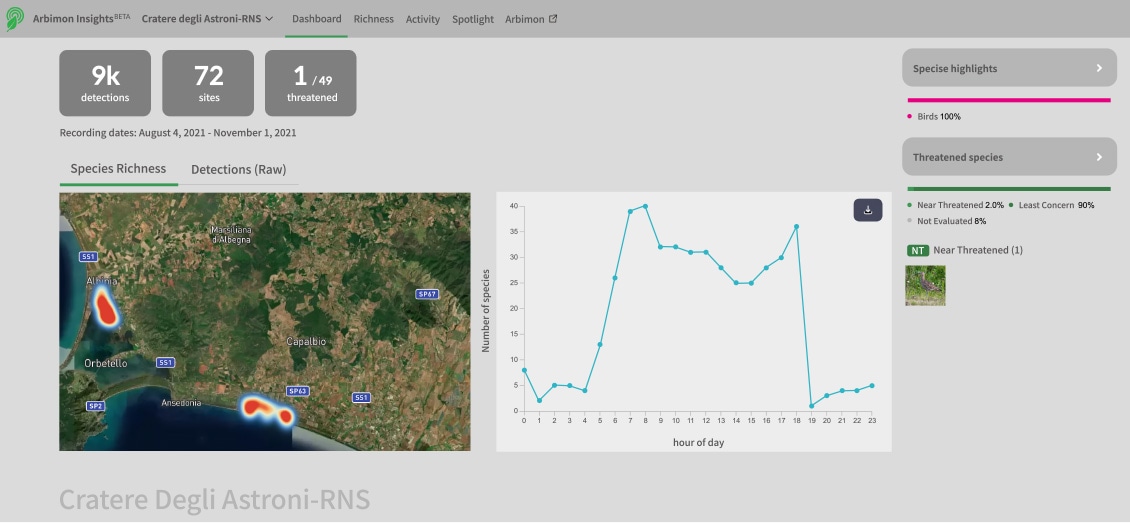
95
million180
yearsArbimon users have uploaded more than 95 million audio files to date – equivalent to 180 years of continuous listening.
Four steps to insight
The tools provided by Arbimon can be broken down into four steps: deploy, upload, analyze, and share.
In the first step, the user configures audio recorders and deploys each one in a unique site in the field. When using AudioMoths and Song Meters, Arbimon’s companion mobile application will automatically link each device to its site location and store deployment photographs to simplify retrieval and provide context to the location.
95
million180
yearsOn retrieval of the device, the next step is to upload the newly recorded audio files. Arbimon provides the Uploader desktop application for macOS and Windows to enable users to queue and send hundreds of gigabytes of files from multiple sites in the background. Arbimon users have uploaded more than 95 million audio files to date – equivalent to 180 years of continuous listening. A significant proportion comes from Huawei sponsored projects, which specifically use Huawei Cloud and Flexible Engine to store and process terabytes of audio data.
With the data uploaded to Arbimon, the third step is to perform analysis to identify species’ calls in the audio. All analyses that run on Arbimon are designed to automate the identification process to varying degrees, ranging from a regional convolutional neural network (CNN) model that automatically classifies multiple species without the need for any input from the user, to pattern matching that requires the user to give a single example of a species’ call on which the algorithm will perform a search to find similar calls. Arbimon CNNs and other analyses are containerized and run on a Kubernetes cluster. Arbimon benefits from the auto-scaling capabilities of cloud computing to run analysis jobs at scale - a single analysis job can process up to 1 million recordings from the platform.
The final step of the process is to visualize and share the results of the analysis. Arbimon provides the Insights module to highlight species’ distribution, richness, and activity patterns. The user interacts with Insights like an analytics tool, but behind the scenes is a custom-built reporting API connected to the time-series database Timescale. Once again, it is the power and scalability of cloud computing that makes it possible to deliver easily consumed dashboards generated from millions of species’ calls outputted by the AI models.
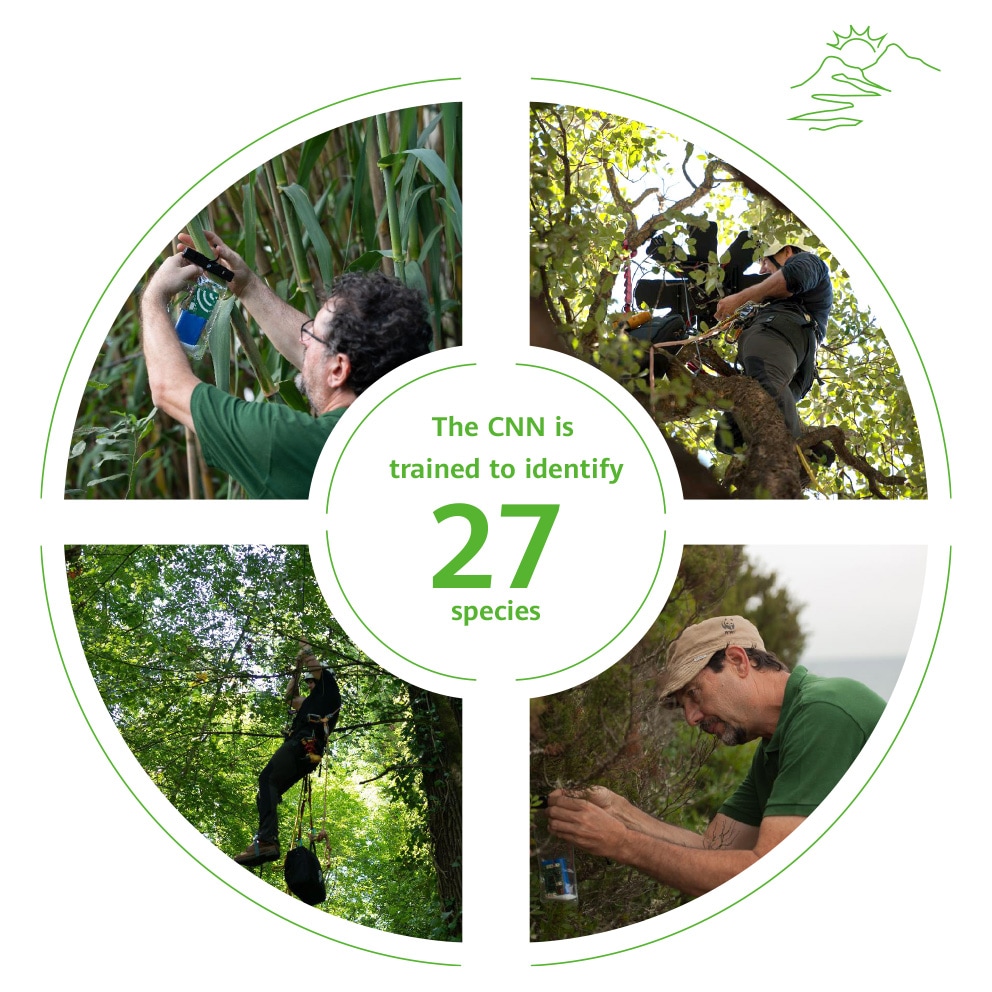
Collaboration delivers results
Huawei had supported 12 biodiversity monitoring projects in collaboration with Rainforest Connection by the end of 2022. One example is work undertaken with the World Wide Fund for Nature (WWF) to map bird species across Italy. In the first phase of the project, audio recorders were deployed in three sites, recordings were analyzed in Arbimon, and a new regional CNN for Italy was trained to detect 27 species. WWF Italy is collecting data from agricultural sites spanning Italy, with the aim of identifying 45 more species for inclusion in the CNN. This will enable greater understanding of how varying agricultural practices impact local fauna and allow us to adopt techniques that contribute to biodiversity health.
WWF Italy will be well-situated to continue to utilize acoustic monitoring across all their conservation projects into the future. By sharing the results on Arbimon, other organizations and individuals can undertake their own studies to automatically monitor species’ presence and map their distributions to understand how the fauna of Italy is responding to conservation management approaches, human encroachment, and climate change.
Through the TECH4ALL program, Rainforest Connection and Huawei are engaged in similar initiatives in 11 other countries that share the same goal: to create cloud-based tools and AI models that make biodiversity monitoring digitally inclusive.
Blockchain’s Untapped Potential in Nature Conservation
Distributed-ledger technologies and blockchain can revolutionize nature conservation by increasing the speed, transparency, security, and efficiency of transactions and tracking. Under the IUCN-Huawei Tech4Nature program, Porini Foundation has developed such a solution to optimize carbon-trading and forest management in a pilot project in Switzerland.
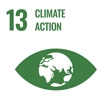

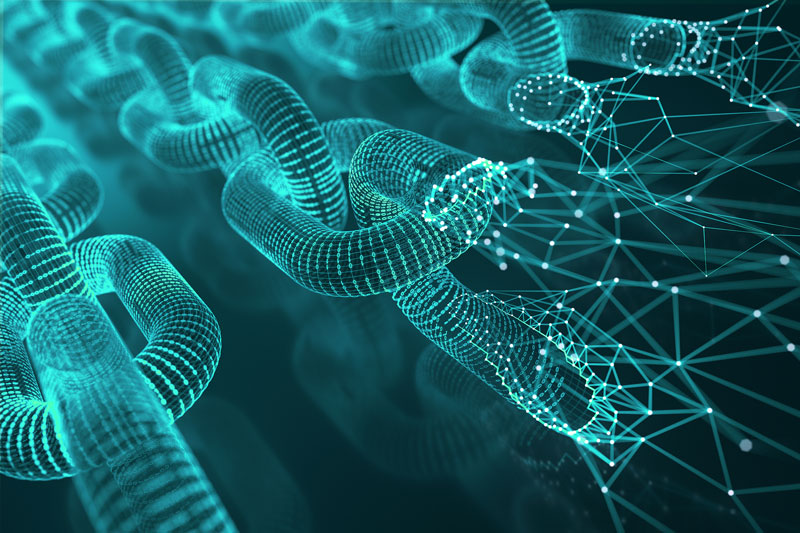
A blockchain structures data into blocks that link together to form a chain. This data structure creates a timeline, with each block given an exact and irreversible timestamp of a specific transaction or tracking event on that chain.
Blockchain explained
A blockchain is a distributed digital database or ledger that records transactions and tracks assets across a business network. Unlike a database that structures data into tables, a blockchain structures data into blocks that link together to form a chain – hence its name. This data structure creates a timeline, with each block given an exact and irreversible timestamp of a specific transaction or tracking event on that chain. As blockchains are decentralized and run on multiple nodes, i.e., computers linked on a peer-to-peer network, the data and timestamps in a given block cannot be altered, deleted, or destroyed.
We can view blockchain and distributed ledger technology (DLT) in the context of the global digitalization process. Since the 1950s, the planet has become increasingly digital and there are many ways to structure these waves of digitalization. In the blockchain context, the first wave is represented by the digitalization of information facilitated by the Internet and email, with both individuals and organizations heavily influenced by the inception of both. The second wave is the digitalization of communities through social media, with a high proportion of the global population and organizations active on social media platforms. The third wave – and what we are seeing today – is the digitalization of value with the introduction of blockchain and DLT.
Blockchain enables us to digitalize assets of any sort, both tangible and intangible, from houses, cars, and land to currency, IPR, patents, and more.
The digitalization of assets relating to nature conservation enables us to map value systems such as ecosystem services, endangered species, and quality standards. We can then bring them to market in an efficient and transparent way and build tools around the digitalized value to create the specified impact.
The easiest use case for DLT is for currency, as it brings speed, transparency, and efficiency into systems where transactions do not require clearing. Settlement occurs in seconds and no trusted intermediary is needed, reducing overall risk. Transactions are also very cost effective and, as the technology is decentralized, no central point of failure or single attack ingress point exists. Depending on the blockchain infrastructure used, all transactions and histories can be inspected with low-tech tools like browser-based block-explorers. Moreover, DLT markets enable business or activity in markets that are open and live 24/7.

Examples of DLT applied to nature conservation
 Carbon Credits
Carbon Credits
 Nature Collectibles
Nature Collectibles
 Gamification
Gamification
How can DLT be used in nature conservation?
There are three major ways we are using DLT to boost nature conservation outcomes: carbon credits, nature collectibles, and gamification.
Examples of DLT applied to nature conservation
 Carbon Credits
Carbon Credits
 Nature Collectibles
Nature Collectibles
 Gamification
Gamification
Carbon credits
Forests serve as powerful carbon sinks and are one of the most economical, safe, and effective means of carbon sequestration. Strengthening forest protection can safeguard the role of existing forests as carbon sinks, enable the sustainable recycling of forest biomass products, and prevent carbon emissions resulting from the degradation of forests and deforestation from entering the atmosphere.
Moreover, a carbon market on blockchain enables direct trading between carbon sink providers and carbon sink buyers, and it can bring an end to inconsistent accounting standards, untraceable carbon sink certificates, and multiple sales of one certificate.
In the voluntary carbon credit market, two out of every three market participants benefit from the transparency and efficiency that DLT brings. As a result, the market is embracing the opportunities that the technology offers, and many players are opting for DLT platforms.
Launched in May 2022, we are running a pilot project in the Appenzell region in Switzerland that uses a new carbon credit methodology, Green List Standards+, to measure the impact of biodiversity measures on capercaillie (a type of grouse) in protected areas in Switzerland based on carbon capture. We have developed a forest carbon sequestration application based on cloud computing, blockchain, and high-precision satellite imagery to boost the transparency and traceability of forest carbon sink transactions.
In turn, this will ensure the sustainable management and utilization of forest resources and increase biodiversity output. So far, we have shown that improved management has resulted in an additional sink of CO₂ of 40 tons per hectare.
Nature collectibles
A second use case for blockchain for nature conservation is to create a market for the direct funding of conservation projects in protected areas – a space that can otherwise suffer from overheads and a lack of transparency.
Blockchain technology enables unique and identifiable digital objects that cannot be copy-pasted. Porini has used this concept to create a collectible trading card ecosystem where users are incentivized to collect and trade digital cards of endangered species. These NFTC (NFT for Conservation) are limited-edition cards, with a new card added to the app every month. With Nature Collectibles, users can buy, hold, or resell a unique animal card; verify on the blockchain that they are the owner of the card; and follow the money flow. For the first sale, 100% of the price paid for the card goes to the named protected area, with the confirmed transaction visible in less than 15 seconds. For all resales, the proceeds of the price increase are divided between the seller and the conservation actor, making the NFTC an investment.
The app, which is available on the Huawei AppGallery, is easy to use, and lets users learn about blockchain and different species and earn money for their card collection and conservation efforts.
Gamification
Gamification is a third way that we are planning to create a positive impact on nature conservation through blockchain. If we act on climate change, for example, the actual impact and the timeframe over which it happens can be unclear. Gamifying impact can give instant feedback in a clear timeframe represented by a familiar concept, i.e., a game.
To this end, we have developed the game ClimateCandy, which will be available in the Huawei AppGallery and will reward users with retiring carbon credits.
Porini foundation works at the crossroads of blockchain and nature conservation, and the technology has huge potential in scenarios that require secure and transparent transactions.
Zero-carbon
With the advantages blockchain offers in the area of nature conservation, we cannot ignore its own footprint. There are many different blockchains, and while some do consume significant amounts of energy, such as the Bitcoin blockchain, we use a very energy-efficient near-zero-carbon blockchain and compensate for its consumption with high-quality carbon certificates. To use a simple metaphor, you can choose to travel by bicycle or by air and, while one is clearly vastly more energy-efficient than the other, it cannot always get you where you need to go.
Porini Foundation works at the crossroads of blockchain and nature conservation, and the technology has huge potential in scenarios that require secure and transparent transactions, including monitoring wildlife, optimizing carbon trading, funding conservation causes, gamification, and verifying contracted performance.
And this is a potential that we are committed to continue exploring.
How AI-powered Drug Design Is Enabling New Super Antibiotics
Existing antimicrobials (AMR) are simply no longer as effective against bacteria as they used to be, with 1.2 million deaths each year caused by AMR, making it more deadly than HIV. By 2050, AMR is expected to result in 10 million deaths per year, which exceeds the current death rate caused by cancer. However, hope is on the horizon.
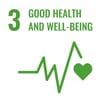
A new hope: Super antibiotics
Professor Liu Bing leads a team at the First Affiliated Hospital of Xi'an Jiaotong University. With a focus on developing revolutionary, broad-spectrum antimicrobial drugs, the team’s most recent discovery is a super antibiotic that combats bacteria in a unique way. They discovered that the bacteriophage protein Gp46 can target and inhibit nucleoid-associated HU proteins, preventing bacterial growth or killing bacteria outright. Unfortunately, Gp46 cannot be directly used as an antimicrobial drug, so Professor Liu Bing began looking into the possibility of using small molecules to simulate the behavior of Gp46.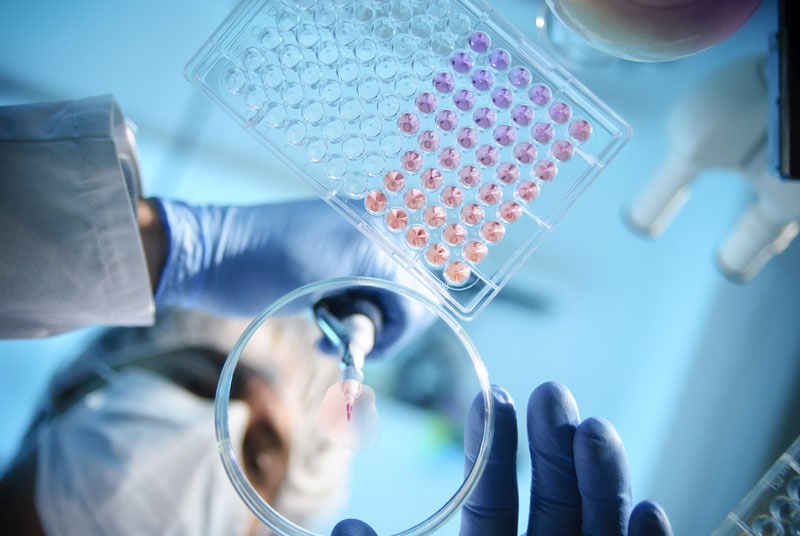
A new hope: Super antibiotics
Professor Liu Bing leads a team at the First Affiliated Hospital of Xi'an Jiaotong University. With a focus on developing revolutionary, broad-spectrum antimicrobial drugs, the team’s most recent discovery is a super antibiotic that combats bacteria in a unique way.
They discovered that the bacteriophage protein Gp46 can target and inhibit nucleoid-associated HU proteins, preventing bacterial growth or killing bacteria outright. Unfortunately, Gp46 cannot be directly used as an antimicrobial drug, so Professor Liu Bing began looking into the possibility of using small molecules to simulate the behavior of Gp46.

70%
reduction in R&D costs
80%
reduction in R&D timeNo new antibiotics for 40 years
Antibiotics are unquestionably one of humanity's greatest inventions, with penicillin and its derivatives saving millions of lives from infection-related deaths over the past 70 years. All told, antibiotics have reduced the number of deaths caused by infectious diseases around the world by 70%, drastically increasing average global life expectancy.
Unfortunately, the misuse and overuse of antibiotics has accelerated AMR, leaving us in urgent need of new and better antibiotics.
For pharmaceutical companies, the development of new broad-spectrum antibiotics has simply not been a lucrative business in the past. Typically, the development of a new drug takes 10 to 15 years and an investment of US$1 to 3 billion. The success rate of this investment is also less than 10%. According to Deloitte, the average cost of developing and launching a new drug in 2020 was US$2.508 billion, a huge increase from the 2010 average of US$1.188 billion. Broad-spectrum antibiotics usually have low profit margins, prompting many large pharmaceutical companies to stop developing new antibiotics.
This is when he decided to turn to artificial intelligence. With the assistance of an AI-supported drug design service powered by Huawei's Pangu Drug Molecule Model, Professor Liu Bing's team quickly discovered a small molecular compound capable of replacing the Gp46 protein.
They then used this to develop a brand-new super antibiotic.
Lab results have already shown that this new super antibiotic has the ability to inhibit the majority of the most drug-resistant bacteria, including Staphylococcus aureus, Acinetobacter baumannii, Klebsiella pneumoniae, and Apicomplexa parasites like Plasmodium and Toxoplasma gondii. The antibiotic is thus a promising new treatment for both drug-resistant bacterial infections and malaria.

70%
reduction in R&D costs
80%
reduction in R&D timeThe Huawei Cloud Pangu Drug Molecule Model was critical in this effort as it cut lead compound development time from several years to a single month, reducing R&D costs by 70%.
The research team used the Pangu Drug Molecule Model's structure optimizer to modify the structure of the drug molecules multiple times, reducing the chance of unwanted side effects by 95%. So far, clinical trials have shown that the new drug can achieve the same or better antibacterial results than a typical antibiotic at only 10% of the dosage.
Most importantly, the new super antibiotic targets HU proteins using an innovative bacteriophage-like mechanism that inhibits DNA replication in bacteria. This makes it exceedingly unlikely that bacteria will be able to develop resistance to the antibiotic. This new mechanism is starkly different to those of existing antibiotics, which fight bacterial infections by attacking the cell wall, inhibiting the synthesis of bacterial proteins, or interfering with the replication and transcription of bacterial nucleoids.
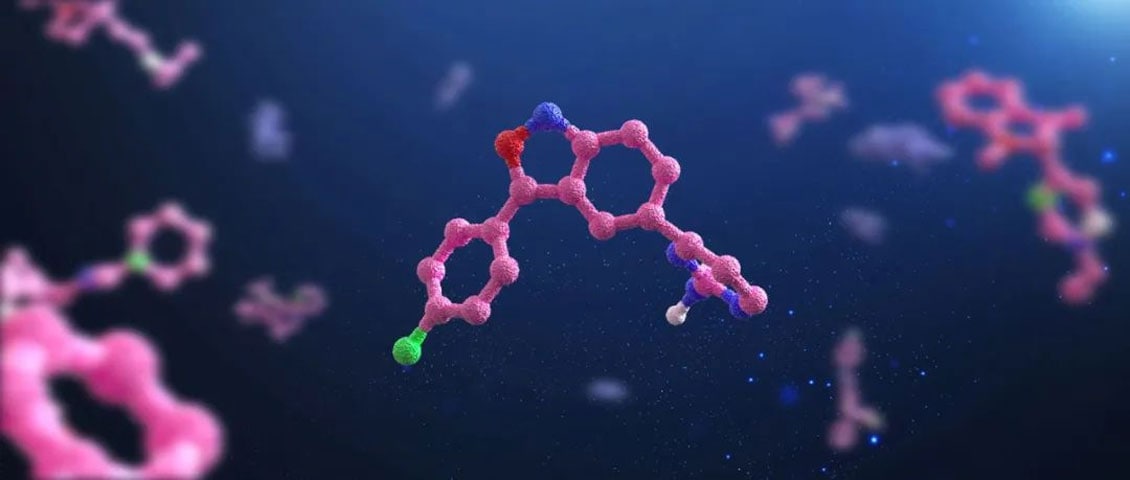 A drug molecule obtained by the Huawei Cloud Pangu Drug Molecule Model
A drug molecule obtained by the Huawei Cloud Pangu Drug Molecule Model
With the Pangu Drug Molecule Model's ability to predict both the physicochemical properties and druglikeness of drug molecules, Professor Liu Bing's team found a preclinical candidate in just a few months, nearly 80% faster than the current average.
 Drug screening with Huawei Cloud's AI-supported drug design service
Drug screening with Huawei Cloud's AI-supported drug design service
Revolutionizing drug discovery with AI
Huawei Cloud's Pangu Drug Molecule Model was co-developed and trained by Huawei Cloud and the Shanghai Institute of Materia Medica under the Chinese Academy of Sciences.
It uses a cutting-edge deep learning network architecture – a graph-sequence asymmetric autoencoder – to learn the features of drug compounds. The data of 1.7 billion known drug-like molecules was used to pretrain the model. Then, through unsupervised learning, it generated the DrugSpaceX library, which contains 100 million drug-like small molecules, each with an entirely novel structure. This library can be used for drug screening and drug molecule design.
The Pangu Drug Molecule Model also predicts and scores more than 80 physicochemical properties of drug molecules such as water solubility, metabolic activity, excretion rate, and toxicity. It then identifies the most drug-like molecules that possess a novel structure. Lab results have shown that the Pangu Drug Molecule Model is 20% more accurate at predicting the druglikeness of drug molecules than conventional methods.
With the Pangu Drug Molecule Model's ability to predict both the physicochemical properties and druglikeness of drug molecules, Professor Liu Bing's team found a preclinical candidate in just a few months, nearly 80% faster than the current average.
 Drug screening with Huawei Cloud's AI-supported drug design service
Drug screening with Huawei Cloud's AI-supported drug design service
Typically, lead discovery during drug development takes three to five years, accounting for up to half of the average 10-year development period. During the lead-discovery phase, researchers have to repeatedly modify drug structures to improve metabolic activity and druglikeness, with almost all of their previous work having to be redone after each modification. However, with the Pangu Drug Molecule Model's remarkable ability to predict both the physicochemical properties and druglikeness of drug molecules, Professor Liu Bing's team found a PCC (preclinical candidate) in just a few months, nearly 80% faster than the current average.
After a candidate compound is selected, research teams then further optimize the compound structure. This process can also be aided by the Pangu Drug Molecule Model's molecular structure optimizer.
The aim of this optimization is to increase the binding energy between the drug compound and target protein, while reducing the binding energy between the compound and other normal proteins. This ensures the new drug is highly efficient and minimizes potential side effects.
AI can boost health and well-being
Drug discovery is crucial to combating disease and improving health, and AI is becoming a powerful tool in this fight.
The Huawei Cloud Pangu Drug Molecule Model and the AI-supported drug design service that it powers represent a promising way to combine AI with medical expertise to expedite drug discovery and promote human health and well-being.
How Open-source MindSpore Promotes Inclusive AI
The open-source nature of MindSpore projects vastly simplifies the development of applications that can benefit society. From conservation to cultural heritage to empowering people with disabilities, inclusive AI in turn boosts inclusion.
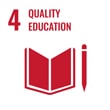
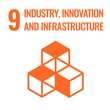
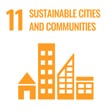
Bringing previously expensive and advanced technologies to the masses has created countless opportunities for programs designed for the public good.
Several endangered scaly-sided mergansers – a type of diving duck – were recently found in China’s Chongqing, but not by conservationists. Instead, they were found by an intelligent bird tracking system developed by the software company Mengdie Huanxiang using Huawei's MindSpore AI framework.
With just a few thousand mature individuals remaining in existence, it is hard for conservationists to identify the small endangered bird in the wild and even harder to track and rescue them when they are injured.
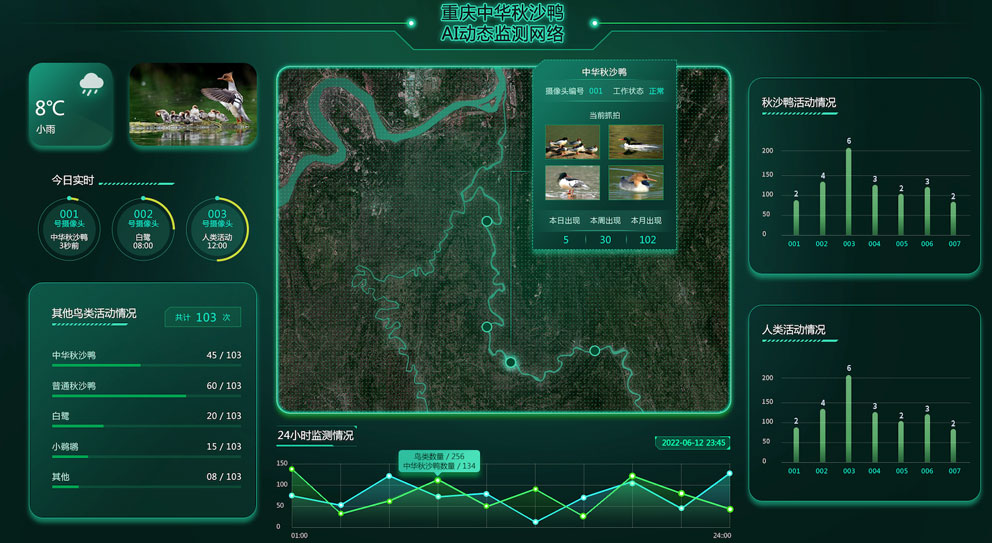 Ascend AI-powered dynamic tracking network for the Chinese merganser in Chongqing, China
Ascend AI-powered dynamic tracking network for the Chinese merganser in Chongqing, China
 Simplified operations
Simplified operations
 All-scenario AI
All-scenario AI
 High-performance execution
High-performance execution
 Ultra-large-scale AI
Ultra-large-scale AI
 AI converged computing
AI converged computing
 AI security and trustworthiness
AI security and trustworthiness
A bird’s eye view
Mengdie Huanxiang's system was trained with MindSpore using more than 500,000 photos of over 5,000 types of birds. The system can identify the gender, age, and behavior patterns of individual birds from a massive amount of video footage and images captured by HD cameras. This system currently has an accuracy rate of 85% and provides 24/7 monitoring, halving the amount of time conservationists have to spend in the field.
Many emerging technical solutions for socially beneficial programs like this rely on advanced AI, but most companies in the field do not have the resources or talent to develop an entire AI system on their own. MindSpore provides a solution for these companies to kick start their technical journey.
Key Features of MindSpore
 Simplified operations
Simplified operations
 All-scenario AI
All-scenario AI
 High-performance execution
High-performance execution
 Ultra-large-scale AI
Ultra-large-scale AI
 AI converged computing
AI converged computing
 AI security and trustworthiness
AI security and trustworthiness
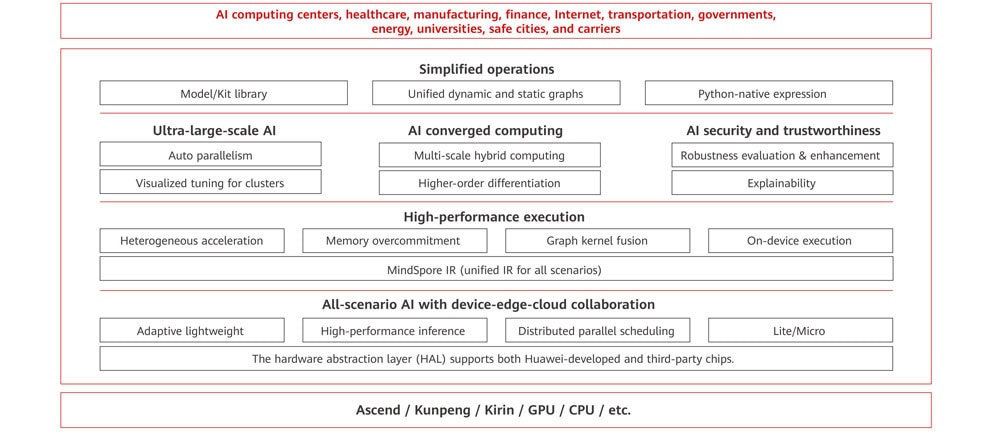 MindSpore technology architecture overview
MindSpore technology architecture overview
Inclusive AI through open source
Open source technologies and communities are gaining traction in the tech world and are very popular with tech enthusiasts. When it comes to AI, open source foundational technologies and infrastructure make app development much, much easier. As a result, passionate developers of open source communities have begun to identify and solve the problems they see in the real world.
The intelligent bird tracking system provides such an example. This system is based on MindSpore, Huawei's all-scenario AI framework, which became open source in March 2020. MindSpore makes development easy by providing foundation models and enabling flexible debugging, hardware and software integration, and rapid multi-scenario deployment. By acting as a kind of operating system for the AI era, MindSpore can also flexibly adapt to different hardware, algorithms, and AI models, as well as support horizontal ecosystem migration.
From preserving cultural heritage to empowering people
The true benefit of AI, as any digitalized enterprise will tell you, is how it uses machine learning – and massive data processing in particular – to handle labor-intensive and repetitive tasks. This allows people to spend more time and energy on high-value, creative tasks. Bringing previously expensive and advanced technologies to the masses has created countless opportunities for programs designed for the public good.
1,200 km to the west of Chongqing, MindSpore is being used to support heritage preservation efforts in the city of Dali. Located in the heart of Yunnan Province, China's most ethnically and culturally diverse region, Dali is home to a wealth of intangible cultural heritage, including a traditional textile dyeing technique called Zaran. In partnership with the encryption artist Song Ting and her team, the MindSpore Community used MindSpore to digitize Zaran patterns passed down from generation to generation. They used the generative adversarial network (GAN) – a critical part of MindSpore – to train models and generate new Zaran patterns that hold enormous appeal to consumers, breathing new life into Dali's Zaran industry.
 New Zaran patterns generated by MindSpore GAN
New Zaran patterns generated by MindSpore GAN
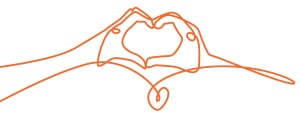
200+
universities5,000+
enterprises3 million
users20,000
contributors273
member organizationsSigning up to inclusion
The software company Keenbow is also using MindSpore, along with the the world's first three-modal large-scale model – Zidong Taichu – from the Institute of Automation, Chinese Academy of Sciences (CAS), to make big waves in the world of sign language. China has 27 million people with a hearing impairment, many of whom use sign language as their primary form of communication. As is the case with many other sign languages, learning Chinese sign language (ZGS) is often difficult due to limited dictionary updates, a shortage of teachers, and inconsistent language standards.
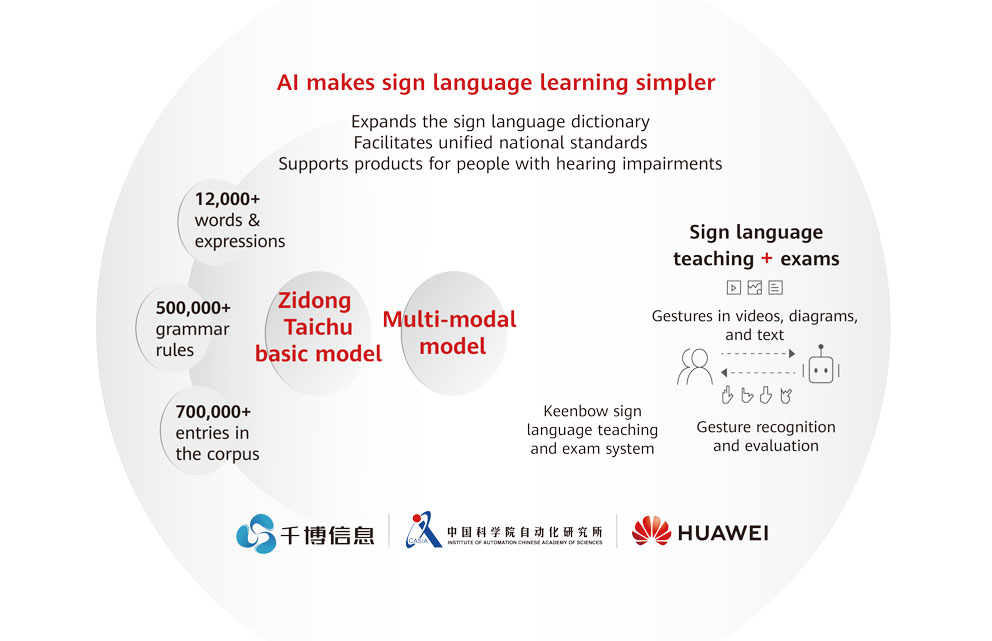
Keenbow's solution is an intelligent sign language teaching and exam system. The system displays sign language gestures through videos, diagrams, and text to make learning easier and more accessible. It can even double as a sign language translator, helping sign language users communicate with people who do not know ZGS.
200+
universities5,000+
enterprisesSurrounding MindSpore, a rapidly growing ecosystem has taken shape. To date, MindSpore has supported the development of AI-related courses in more than 200 universities, and worked with even more universities to deliver specialized training. MindSpore is also the subject of a variety of public classes, bootcamps, and clubs, providing developers with more opportunities to learn and work together. Currently, MindSpore has supported more than 5,000 enterprises across e-government, finance, manufacturing, transportation, energy, and many other industries in developing intelligent applications. More than 600 papers on MindSpore have been published at top academic conferences.
3 million
users20,000
contributors273
member organizationsSo far, the MindSpore Community includes more than 3 million users, 20,000 contributors, and 273 member organizations. It is currently the most active community on Gitee, a platform that hosts more than 10 million open source software projects.
 MindSpore Community activities
MindSpore Community activities
Tracking mergansers, digitizing cultural heritage, developing a sign language system – none of these use cases would be possible without the vast open-source MindSpore technology powering the way forward. One of the core targets of MindSpore is supporting digital inclusion by specifically helping AI developers to make the world a better place. By leveraging AI, developers are able to tackle the social issues dearest to their hearts with advanced technologies that socially beneficial programs have traditionally lacked access to.
A Solar Oasis Breathes Life into a Desert
Once known locally as the "sea of death", China's Kubuqi Desert covers more than 20,000 km². Today, solar power is gradually transforming this once barren expanse into a fertile landscape, and in doing so revitalizing the economy and changing the lives of those who call the desert home.
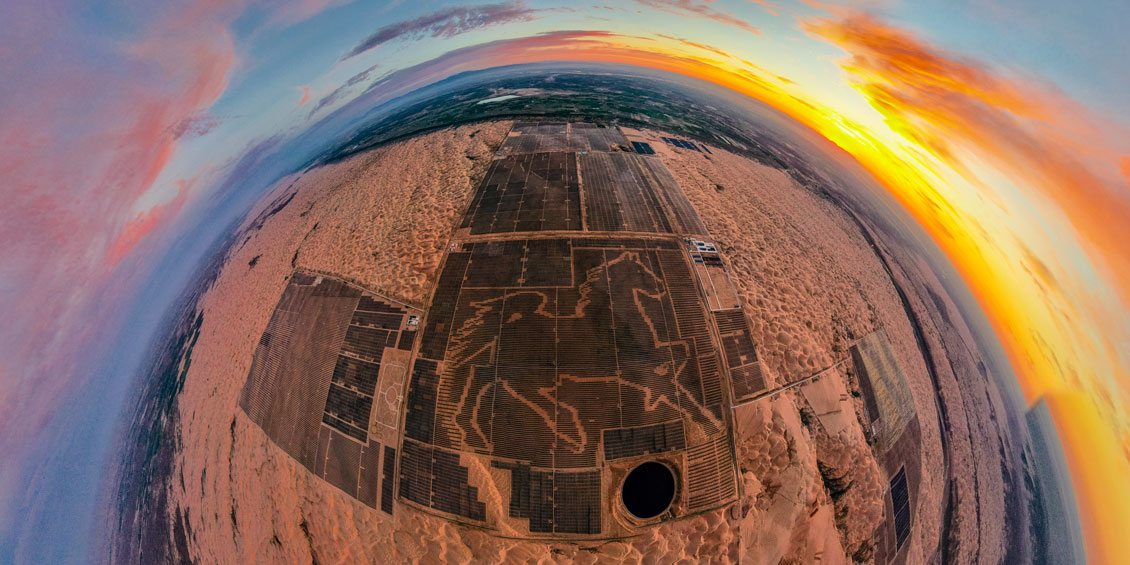 Aerial view of the SPIC Dalate Solar Power Station
Aerial view of the SPIC Dalate Solar Power Station
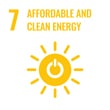

The Kubuqi Desert lies on the Ordos Plateau in northwestern China. Covering 20,000 km², it is the country's seventh largest desert and one that had gained local notoriety as the "sea of death".
Over the last decade, however, a mix of conservation and construction work has created an oasis of vegetation in the Dalate Banner, the region in the center of this once barren land.
Wild foxes, hares, and other wildlife are now a frequent sight. But it is the view from the air that gives many pause.
Designed in the shape of a galloping horse, the huge landmark is actuality a solar power station – one that is as powerful as it unique. Built by the Inner Mongolia Energy Company under the State Power Investment Corporation (SPIC), the 300-kW station boasts 196,000 solar panels arranged in a distinctive equine pattern that evokes the natural power that the plant is capable of.
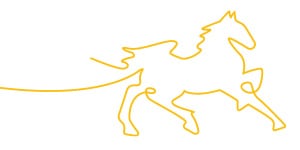
In the local culture, horses symbolize hard work, perseverance, and determination.And it is these very attributes that have driven efforts to control desertification in the area over the past three decades.
Solar power holds back desertification
35-year-old local Zhao Jinlong is one of many villagers who directly benefits from the construction of the ‘Horse Power Station’, as the plant is locally known.
"When I was a child, sandstorms were a common occurrence," recalls Zhang. "When they came, the sky turned yellow and the sand was inescapable. If you walked into the wind, the sand would scratch deeply into your face and skin."
Now he works as an operations and maintenance technician at the power station. "When I get off work, I take a minute to just stand outside and watch the sunset. I like taking photos of the solar panels and imagine a small horse running on the grassland. The difference is really amazing," he says.
Like Zhao, many other locals are employed at the power station, allowing them to stay in the region where they grew up and take care of their families.
In the local culture, horses symbolize hard work, perseverance, and determination.And it is these very attributes that have driven efforts to control desertification in the area over the past three decades.
In the local culture, horses symbolize hard work, perseverance, and determination. And it is these very attributes that have driven efforts to control desertification in the area over the past three decades – efforts that have culminated in the unique Kubuqi model for combating what amounts to a serious environmental threat.
Combining policy support, sustainability initiatives, investment from industry, and the economically-incentivized involvement of the local community, the Kubuqi model has generated significant interest in the international community. According to the UN's 2017 Report on Ecological Wealth Creation in China's Kubuqi Desert, 6,253 km² of the Kubuqi Desert has been reforested, creating a monetary value of more than 500 billion Chinese yuan (approx. US$74.47 billion) and lifting more than 102,000 locals out of poverty.
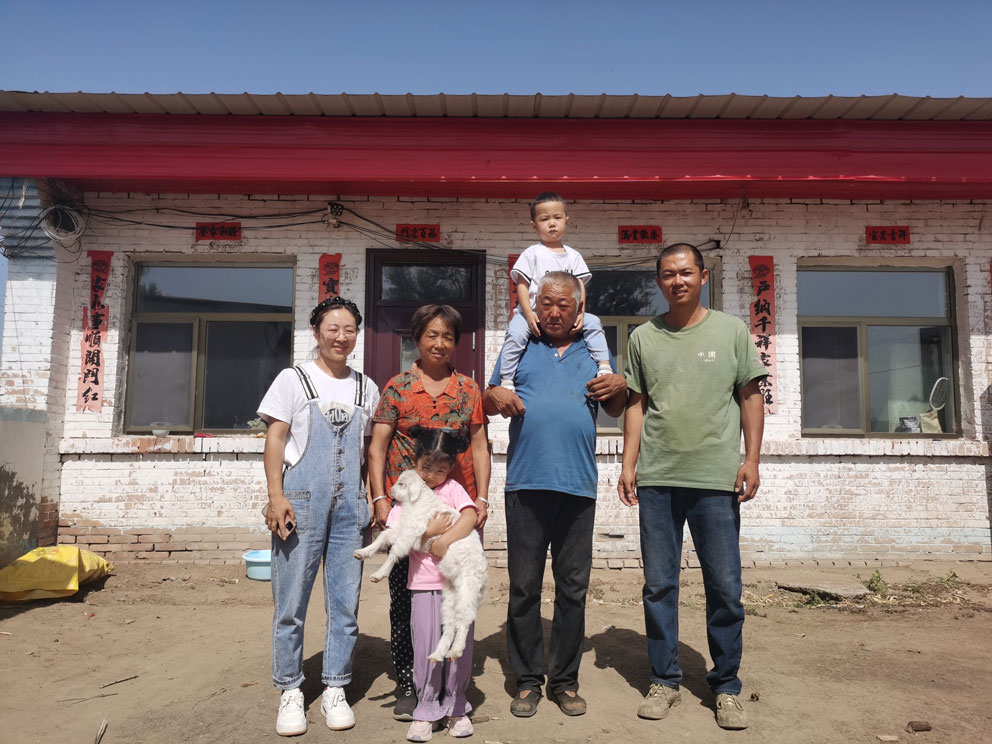
In 2017, China's National Energy Administration announced new guidelines on implementing the Forerunner Program to promote the development of solar power. Jumping on the opportunity, Dalate Banner launched a project to build a 2,000-MW solar power station over an area of 6,700 hectares.
The first project meeting was held on May 29, 2018 and by August 5, construction had started. After just 133 days, Phase 1 of the SPIC Dalate Solar Power Station project had been completed. With the station online and connected to the energy grid, the project became the fastest construction of a 300-MW solar power station in China's history.
The power station's design was also unique, focusing not just on power generation but also on desertification controls and ecosystem restoration. A crucial part of the design was installing mesh and plants under the solar panels. However, finding plants that would grow on the then barren land was not easy. First, oleasters (Russian olive trees) from Ningxia were planted, but less than 10% survived. Next, indigo bushes were planted, which thankfully had a higher survival rate. The indigo soon began benefiting herders, as the plant can be used to feed cattle and sheep after it is harvested in winter.
Now in charge of production safety management, Li Shuaikun was one of the station's first on-site engineers. "We started in April 2018 and the schedule was just so tight. In the beginning, there were barely any plants here," he says, recalling the days when construction had just started. "But now, we have herbs, jujube trees, and ground plants for cattle and sheep. Even the withered branches we use to fix sand have survived and grown tall. Now we have so many plants that we have to remove some in winter to prevent fires. Last year, we even planted watermelons besides the lake, but they were all eaten by birds."
The solar panels have also reduced wind speeds on the ground by 50%, allowing farmers to cultivate fragile herbs used in Chinese medicine. The new vegetation has also accelerated sand fixation – what once required ten years now takes just four.
The project has had measurable effects on the local economy. Local residents use the solar farm as pasture land or for growing cash crops, and – like Li and Zhao – many are employed by the power station. The desert is also becoming something of a tourist attraction, with the influx of new capital helping to upgrade local hotels, supermarkets, and restaurants to cater for the new demand.
Future plans will expand the station further into the desert and increase its capacity to millions of kilowatts, positioning the plant as a showcase for clean energy that can generate an annual electricity yield of 4 billion kWh and an annual economic value of 2 billion Chinese yuan.
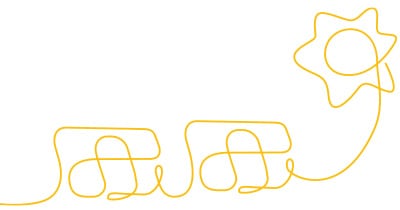
2.312
bn. kWh
of green power generated as of August 20221.85
million tons
of CO₂ emissions offset by green power generation30
engineers
only are needed to manage the whole 400-MW solar plant20
minutes
The time it takes to completely scan the 300-MW power station for faultsThe smart engine driving the horse
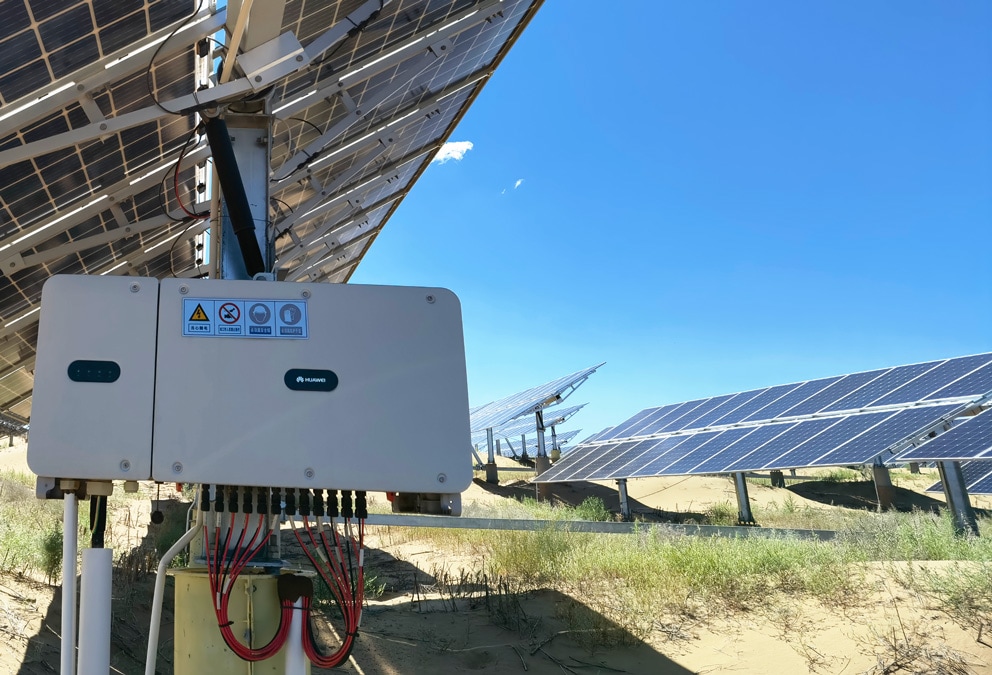 A Huawei smart string inverter at the power station
A Huawei smart string inverter at the power station
Local growth has been supported by the Forerunner Program, an initiative that provides incentives for using leading products and technologies.
The Dalate Power Station uses Huawei's smart PV solution, which combines string inverters, power line communication (PLC), and smart I-V curve diagnostic technologies with a smart PV management system.
A project manager in the station notes that, "We have worked with Huawei on many projects over several years. Their string inverters perform better than equivalent products in the market, especially when it comes to heat dissipation. Another key feature of the inverters is that they have no fans, which is very important in sandy environments, as inverters with built-in fans fail very easily when sand gets in."
There are currently 3,300 intelligent string inverters running in Dalate Power Station. Multi-channel MPPT has addressed string mismatch problems, allowing the station to produce more electricity. The inverters are also rated at IP66, the highest production level in China. As well as containing no fans, the inverters are also free of fuses or fragile parts, helping them withstand the desert’s high temperatures and sandstorms. The Smart I-V Curve Diagnosis 4.0 solution has also revolutionized operations and maintenance (O&M), displaying the real-time status of all parts of the power station on a big screen in the O&M center, so that technicians can accurately locate any PV string faults. The system automatically generates diagnostic reports and provides timely energy yield loss evaluations and repair plans, boosting both O&M efficiency and energy yields.
"Currently, 14 types of PV string faults can be identified, covering more than 80% of major faults," explains Miao Ruijun, the current head of the plant. "The 300-MW power station can be completely scanned in just 20 minutes. And combined with drone inspections and wearable devices, we only needed 30 on-site O&M engineers to manage the total 400 MW solar plant."
2.312
bn. kWh
of green power generated as of August 20221.85
million tons
of CO₂ emissions offset by green power generation30
engineers
only are needed to manage the whole 400-MW solar plant20
minutes
The time it takes to completely scan the 300-MW power station for faultsBy the end of August 2022, the Dalate Power Station had produced a total of 2.312 billion kWh of green power, a carbon-offset equivalent to 760,000 tons of standard coal, which has in turn reduced CO₂ emissions by about 1.85 million tons and supported sand fixation over an area of 1,000 hectares.
Future plans will expand the station further into the desert and increase its capacity to millions of kilowatts, positioning the plant as a showcase for clean energy that can generate an annual electricity yield of 4 billion kWh and an annual economic value of 2 billion Chinese yuan.
Future plans will expand the station further into the desert and increase its capacity to millions of kilowatts, positioning the plant as a showcase for clean energy that can generate an annual electricity yield of 4 billion kWh and an annual economic value of 2 billion Chinese yuan.

Cementing the project’s position as a demo site for hybrid land use, it is also planned to cultivate vegetation over a total area of 13,000 hectares and develop a desert tourism and training base that can host 150,000 visitors a year.
That said, the plant’s current achievements are nothing short of impressive – the project has received numerous national and international awards and holds the Guinness World Record for the world's largest solar panel image.

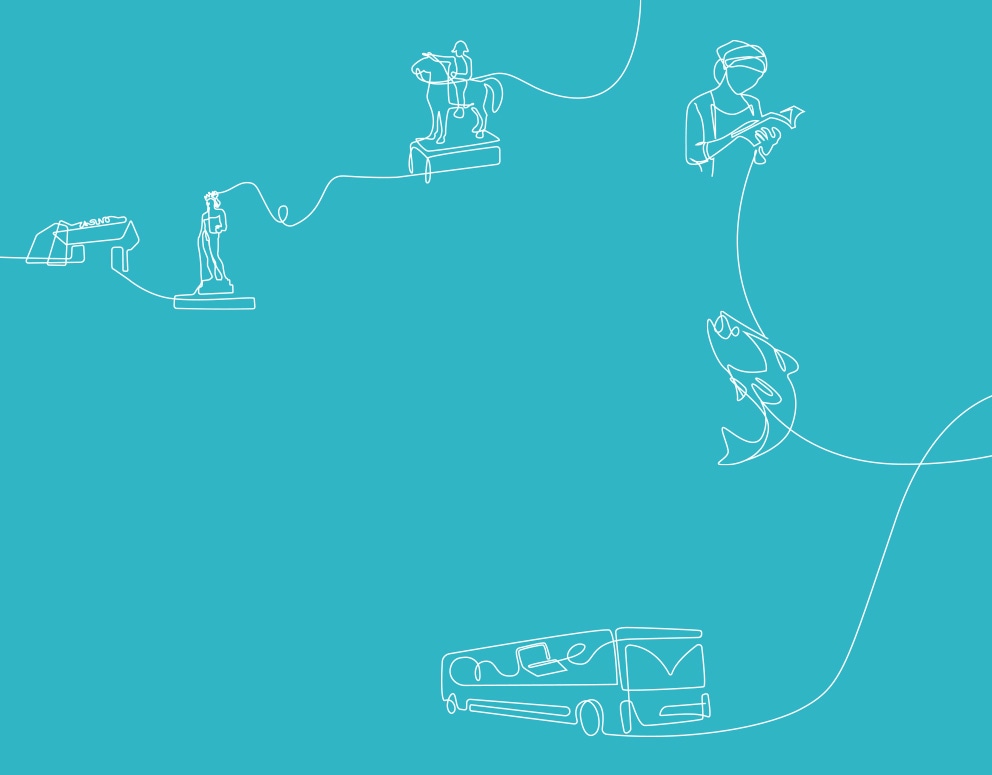
Case Studies
Connecting the Unconnected
The Untold Story of Expanding Digital Inclusion in Ghana’s Rural Communities
Ensuring universal access to Internet connectivity and closing the digital divide are major priorities for Ghana’s development agenda, digital inclusion goals, and post-pandemic recovery. And as a leading light in Africa in terms of digitalization, the nation is on the cusp of becoming a digital economy.


In 2021, His Excellency Nana Addo Dankwa Akufo-Addo, President of Republic of Ghana, remarked that, "Our government is using digital technology to stimulate growth in the economy.” With the government positioning digitalization as a key driver of sustained and inclusive economic growth, ensuring universal access to Internet connectivity and closing the digital divide remain major priorities on Ghana’s development agenda, especially in terms of achieving the UN Secretary-General’s Digital Inclusion Goals and supporting post-pandemic recovery.
And Ghana today is on the cusp of becoming a digital economy.

130.37%
total penetration of voice service subscriptions (June 2022) representing an increase of
representing an increase of
2.31
million people in 2012 to17
million in 2022, i.e.,53%
of the populationNo one gets left behind
Access to connectivity is creating various opportunities, especially for low-income households. For example, the introduction of digital payment systems, such as mobile money platforms, are enabling financial inclusion for many unbanked people. Barriers to education are gradually being dismantled, with the frontiers of education expanding, as eLearning, distance training, distance learning, and massive open online courses (MOOCs) become mainstream. As well as education, evidence of the immense benefits of connectivity are being seen in other sectors of the economy such as health, agriculture, and governance.

130.37%
total penetration of voice service subscriptions (June 2022) representing an increase of
representing an increase of
2.31
million people in 2012 to17
million in 2022, i.e.,53%
of the populationCurrent statistics position Ghana as one of the leading African nations in terms of progress with digitalization. The quarterly report from the National Communications Authority (NCA) recorded a total voice penetration of 130.37% as of the end of June 2022, with actual subscriptions hitting 40.98 million. This represents an exponential increase in penetration from 2.31 million people in 2012 to 17 million in 2022 – about 53% of the population. While this jump is spectacular, the reality is that about 40% of the Ghanaian population remains unconnected. More recent data from Ghana Statistical Service, released before the commencement of the 2021 Population and Housing Census (PHC), identifies a coverage gap in almost 12,000 communities nationwide, with about 30% of this population reported to be living in rural areas. These areas are characterized by common characteristics such as low population density, low income, geographical challenges (particularly around the middle belt of the country), and distance between settlements. These characteristics have presented major barriers for Mobile Network Operators (MNOs) to establish a footprint in these communities.
Simply put, the economics are unattractive.
In response, the government of Ghana launched the ambitious Ghana Rural Telephony Project and Digital Inclusion Project (GRTP & DIP). Financed with a €155-million loan from China Exim Bank under the Ministry of Communications and Digitalization, the project is designed to extend connectivity to 2,016 unserved communities across the country, with the Ghana Investment Fund for Electronic Communications serving as the implementing agency.
As a Public-Private Partnership, the project applies a unique Tripartite Revenue-Sharing Model for the key partners.

RuralStar
cuts deployment costs by50%
ICT has become so critical to everyday life that the government could not afford to deny any of its citizenry network access. The government aimed to establish more than 1,000 cell sites across the country by the end of 2020.
50%
lower cost than traditional cellular base stationsAffordable and effective
RuralStar
cuts deployment costs by50%
Project success hinges on deploying a solution capable of addressing the challenges affecting rural communities. It needs to provide seamless and reliable voice and data connectivity to all residents, while ensuring strong ROI – or at least break-even potential – for MNOs. Extensive research by the consortium, which comprises GIFEC, Huawei, and MTN, identified Huawei’s RuralStar as the optimum solution for the project. Designed as a lightweight rural network coverage solution, RuralStar supports 2G, 3G, and 4G connectivity and cuts deployment costs by 50% compared to traditional cell sites, making it economically viable. Compared with the Rural Telephony Project, RuralStar also lowers the barrier of entry for communities. For example, it decreases the population criterion for deployment from 2,000 to just 500 people, providing that local amenities like schools and markets are sufficient to stimulate and sustain demand for Internet services.
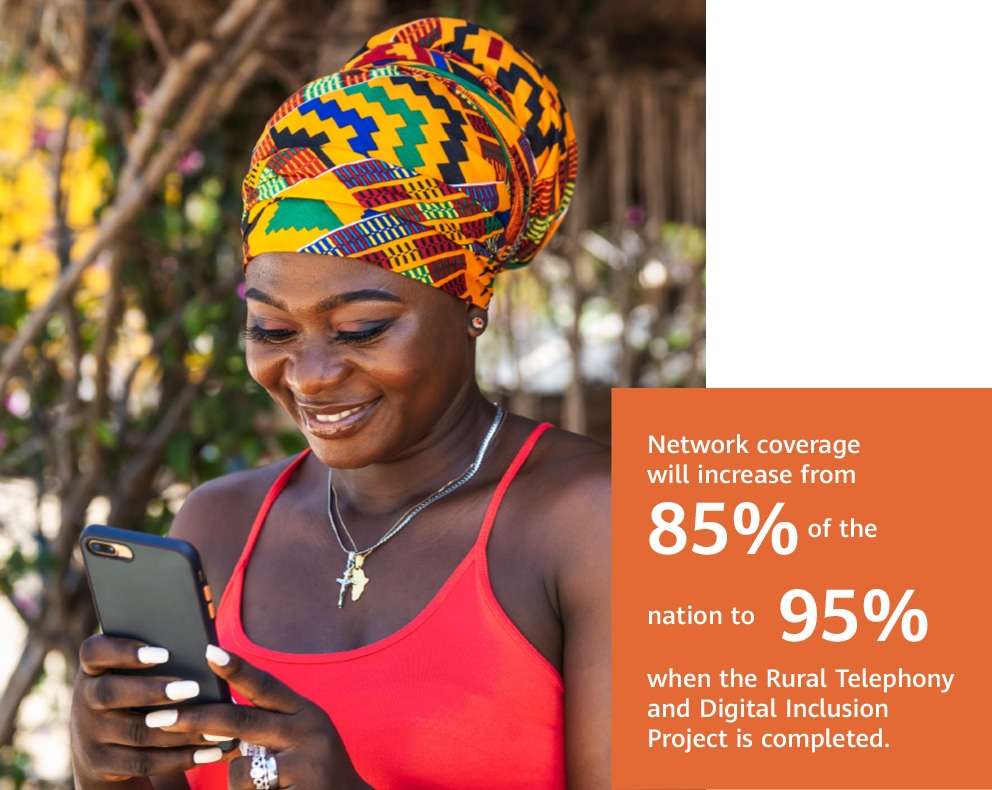
The project has the potential to connect three million people to innovations introduced by the government during its digital transformation drive. Some of these include digital access to high-value processes, from acquiring a passport, driver’s license, or national ID card to registering a business and enabling paperless port clearance for enterprises. Other benefits include access to e-pharmacies to buy medicine, e-ticketing platforms, and a unique geo-located digital address system.
ICT has become so critical to everyday life that the government could not afford to deny any of its citizenry network access. The government aimed to establish more than 1,000 cell sites across the country by the end of 2020.
According to Ursula Owusu-Ekuful, Minister of Communications and Digitalisation for Ghana, “ICT has become so critical to everyday life that the government could not afford to deny any of its citizenry network access. The government aimed to establish more than 1,000 cell sites across the country by the end of 2020.”
50%
lower cost than traditional cellular base stationsOn November 4, 2020, the first site was successfully launched by the President of the Republic of Ghana, His Excellency Nana Addo Dankwa Akufo-Addo, at Atwereboana, a rural community located in the Ashanti Region. Further deployments were made over the next two years, connecting around 1,000 rural sites and 1.5 million people across the country. The beneficiaries were primarily low-income households, which now enjoy greater opportunity to participate in the emerging digital economy, especially in the post-pandemic era. Citizens have been given a greater voice in governance and political processes and are better positioned to start micro, small, and medium (MSME) enterprises, interact socially, and enjoy more education opportunities.
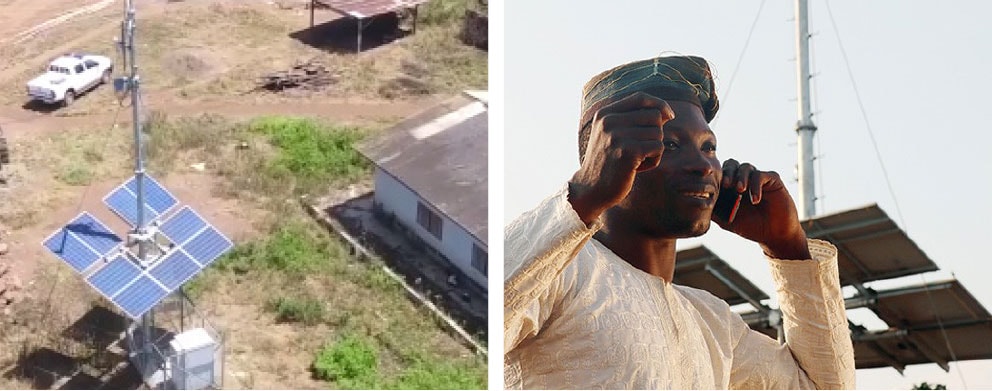
Breaking down barriers
To ensure that no segment of the population is left unconnected, the project acknowledges that potential barriers exist in beneficiary communities in terms of digital skills.
"To function effectively in the digital economy, it is essential to build the capacity of Ghanaians, to take full advantage of the 4th Industrial Revolution, which has fundamentally changed the way we live, work and relate with each other, through technology."
Prince Sefah, Administrator for GIFEC.
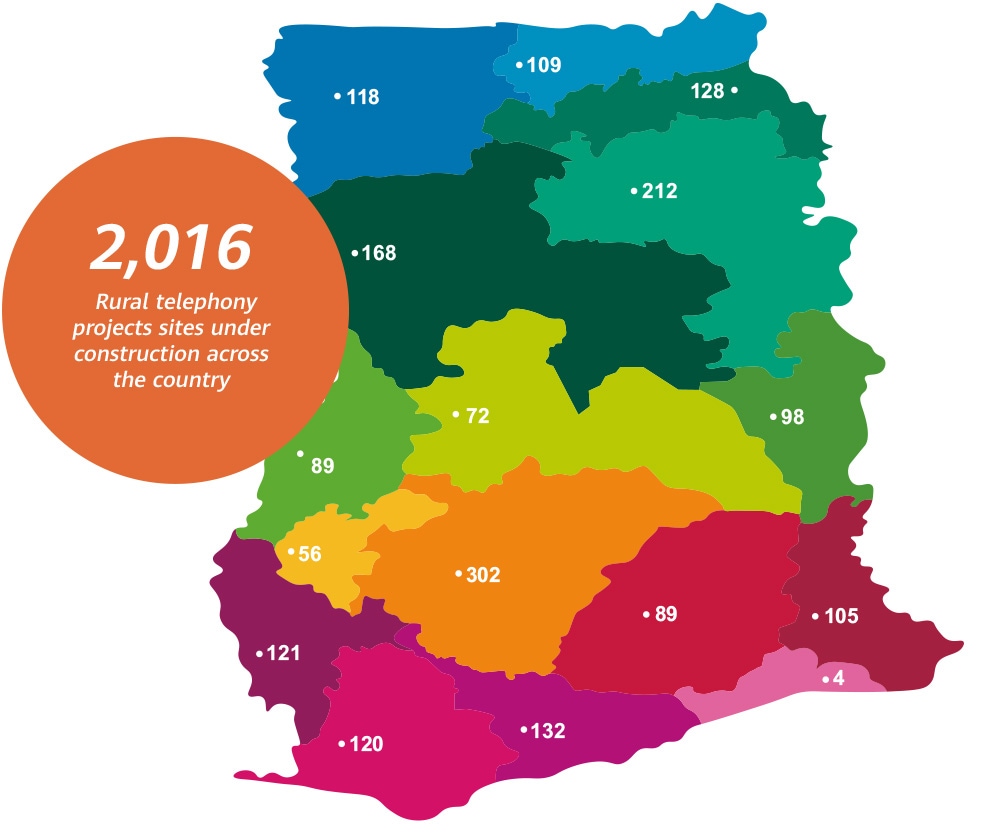
5,000
girls across five regions in 2022Moreover, gender inequality remains an acute issue in Ghana. Many women lack the required level of digital literacy, especially in rural areas where more than half the population use no form of ICT. So, as part of project implementation, digital literacy training was planned by the government through GIFEC. In 2022, the annual Girls-In-ICT program trained 5,000 girls across five regions in 2022. Similarly, the Digital Transformation Centre (DTC) project has provided training for 14,000 people from a diverse range of backgrounds in basic and intermediate ICT skills, with the majority of trainee positions allocated to women. Targeted training is consolidated by initiatives like ICT for Women Empowerment (ISEWE) and Girls can Code, which aim to expand digital literacy under GRT & DIP. Both initiatives have cumulatively provided training for more than 2,000 women over the past two years.
However, it is worth noting that many rural communities are very traditional and do not encourage women to be receptive to using such modern tools. In 2018, the nation’s National Cybersecurity Authority (NSA) designated October as a nationwide cybersecurity awareness month, which has proven crucial for expanding awareness about digital access, data privacy, and cybersecurity, in turn boosting the confidence of many women to start using digital tools.
Providing assistive technologies to people with disabilities is also a project priority. GIFEC is supporting several institutions in the provision of training and digital solutions, including a collaborative training program with the German Development Agency (GIZ) that is currently running in a number of communities.
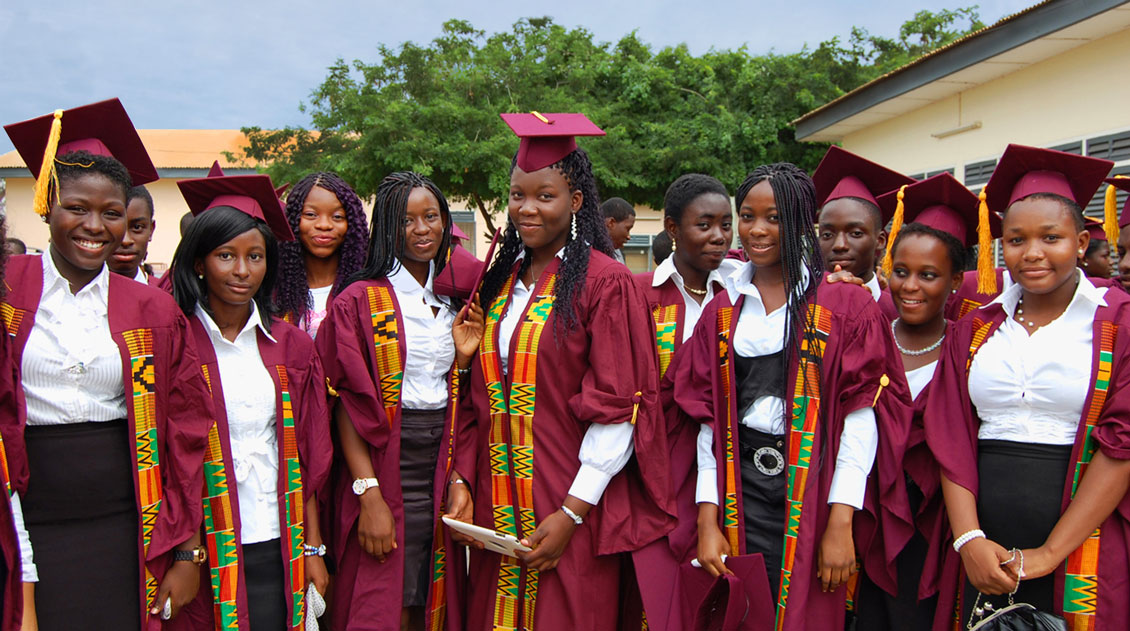
Ghana Beyond Aid
The acceleration of digital transformation in Ghana is poised to enable leapfrog development, make the vision of ‘Ghana Beyond Aid’ a reality, and give the nation a stronger footing for withstanding the current economic turmoil the world is experiencing.
Universal Service Obligation
Connecting Thailand’s Remote and Rural Villages to the Digital World
Rural communities are often the last to be covered by network connectivity. Not only does this prevent access to online services like healthcare, education, public services, and e-commerce, it stops economic growth before it starts. However, that is now changing in Thailand: meet the USO.

At the start of 2022, 52.8% of Thailand’s population lived in urban centers and 47.2% lived in rural areas. And also at the start of 2022, the Internet penetration rate in Thailand stood at 77.8%, with the ITU estimating that 85% of Thailand’s 70 million people were active online as of 2020, continuing a rising trend of connectivity.
Thailand has indeed made strong advances in national-level digitalization through its Thailand 4.0 strategy and the government’s commitment to forging a digital nation. As is the case in many nations, however, rural communities are at risk of being left behind when it comes to connectivity. Deploying network solutions to connect remote communities has tended to be prohibitively expensive for carriers, with low ROI and geographical barriers like mountains and distance making traditional solutions unviable. In Thailand, the rate of Internet use drops significantly outside of Bangkok. In the northeast region, 56.8% of people were using the Internet as of 2019, with figures slightly higher in northern and southern Thailand at 59.6% and 65.2%, respectively.
For those lacking online access or who face challenges using the Internet, the digital world and the services and opportunities it offers are out of reach.
For many villages, geographical isolation coupled with digital exclusion has resulted in a cycle of poverty.
Remote and isolated
This is the case for many villages tucked away in the undulating mountains surrounding Chiang Mai in north Thailand. The small village of Maetoh, for example, is framed by mountains that form a natural barrier keeping villagers isolated. Spanning 60 kilometers, just one mountain road connects Maetoh to the nearest city, but it is frequently flooded and impassable. Unfortunately for villagers, the road provides a lifeline to many essential services.
As local healthcare facilities are poorly equipped residents are forced to take a long trip to get to the nearest city hospital. Assuming the road is usable, the round trip uses up most of the day. For low-income farmers, a day off work is not something that they can afford. Equally, in many mountainous villages online business opportunities are non-existent and local incomes are low, so farmers are often forced to take perishable produce down the mountain to sell at the roadside or at local markets. As buyers know that villagers would rather sell at a low price than take perishable goods like fruit home, profits and thus incomes remain low. The situation is no better at local schools, with the lack of broadband connectivity meaning that children have to use outdated textbooks, unable to access the vast array of learning resources available online.
For many villages, geographical isolation coupled with digital exclusion has resulted in a cycle of poverty.

Training provided by the USO team will help more villagers change their lives for the better and achieve the overarching aim of digital inclusion – to ensure that no one is left behind.
USO Net Centers: Working for digital inclusion
Launched in 2003 under the "Notification of the National Telecommunication Commission Regarding Criteria, Methods, and Conditions for Universal Service Obligation", and administered by the National Broadcasting and Telecommunications Commission (NBTC), a key mission of Thailand’s Universal Service Obligation (USO) is to extend both wired and wireless telecommunications networks and extend the USO project throughout Thailand.
Bridging the telecommunications gap is key to social and economic development and raising the overall quality of life for people in Thailand, and the NBTC has remained committed to that goal. Since 2005, USO NET Centers have been established alongside USO connectivity projects to promote the use of computers and the Internet, both for work tasks and as learning centers for children and the general public. In 2010, NBTC set the target of establishing USO Net Centers in 520 schools. For other priority beneficiaries, such as people with disabilities, older citizens, and low-income communities, NBTC set the target of building USO NET Centers for 408 target communities.
Crucially, USO NET Centers enable children and adults to develop the skills required to use digital technology in daily life. And this is a key point: simply providing connectivity is not enough for meaningful digital inclusion outcomes. While the ITU reports that 82% of rural households in Thailand were connected to the Internet as of 2020, an Internet connection at home does not necessarily mean having a computer at home, an affordable Internet plan, or the skills to use computers or other devices – all gaps to inclusion that are especially apparent in rural communities.
As part of the USO initiative, NBTC planned several projects to run in tandem with connectivity projects and USO NET Centers. These include organizing courses to support the creative use of IT tools, establishing learning networks, and coordinating with other organizations to provide state-of-the-art content and applications.
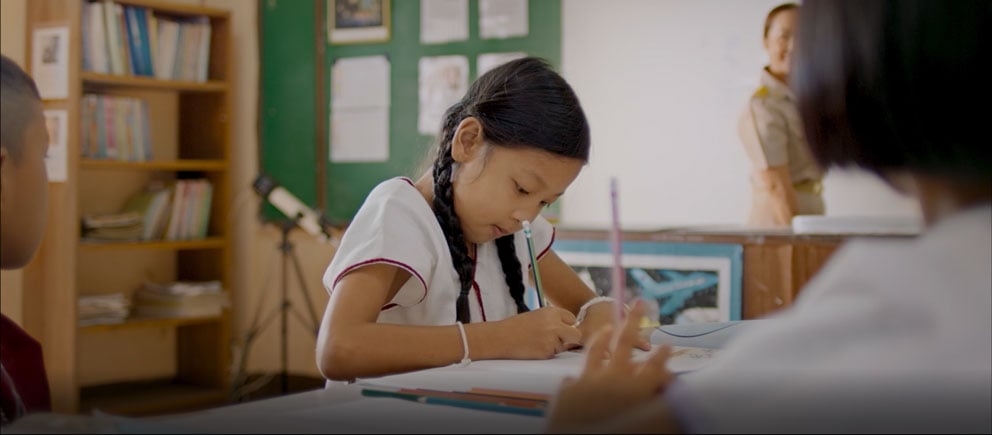
19,652
villages covered by USO broadband 2.0 Children in villages can use computers to access the Internet just as city kids can
Children in villages can use computers to access the Internet just as city kids can
 Telemedicine provided at small hospitals reduces the need for long trips to the city
Telemedicine provided at small hospitals reduces the need for long trips to the city
 Farmers can sell their produce online through broadcasts
Farmers can sell their produce online through broadcasts
The road to digital inclusion
So, given the technical and cost constraints of connecting remote and rural villages, what approaches have been taken so far to connect the unconnected?
Connectivity solutions for USO projects have to be carefully selected and planned to be viable. In 2018, for example, the project team found that communities in mountainous villages surrounding Chiang Mai were not just far from the city, but also that residents were scattered across the village in relatively loose-knit communities. As a traditional fiber-to-the-home (FTTH) solution requires equipment rooms and dozens of kilometers of fiber cables, deployment is not only prohibitively expensive, but the resulting carbon footprint also creates an unsustainable connectivity model.
For the village of Maetoh near Chiang Mai, an innovative solution came in the shape of Huawei's AirPON solution. AirPON is designed to reuse existing poles and fiber resources to create an “equipment room in the air”, enabling gigabit fiber broadband services for hard-to-reach communities that are affordable and green, with low power requirements. For Maetoh, a USO NET Center was established and additional fiber cables were laid, enabling broadband and Wi-Fi services to cover the whole village.
 Children in villages can use computers to access the Internet just as city kids can
Children in villages can use computers to access the Internet just as city kids can
 Telemedicine provided at small hospitals reduces the need for long trips to the city
Telemedicine provided at small hospitals reduces the need for long trips to the city
 Farmers can sell their produce online through broadcasts
Farmers can sell their produce online through broadcasts
The online world had arrived: In the USO NET Center, children from the local school can use computers to access the Internet and the rich array of online education resources. This represents a crucial step for digital inclusion, as it levels the learning playing field with students in cities for whom Internet access is taken for granted. The center also enables rural children to develop digital skills from a young age. The telemedicine service provided at the small hospital means that trips to the city hospital can now be taken only when necessary. Residents can visit the village doctor at the center, who in turn can consult with a city-based specialist if required. Older people can stay in touch with younger relatives working in the city and keep pace with what is happening in the outside world. And farmers can sell their produce online through broadcasts, opening up new markets and driving up incomes, which benefits the economic growth of the whole community.
19,652
villages covered by USO broadband 2.0Strong progress has been made since the project’s inception and its evolution: USO 2.0 has provided broadband services to 19,652 villages, and USO 3.0 is currently under planning. Training provided by the USO team will help more villagers change their lives for the better and achieve the overarching aim of digital inclusion – to ensure that no one is left behind.
A Case Study of Kenya
ICT Integration in Basic Education

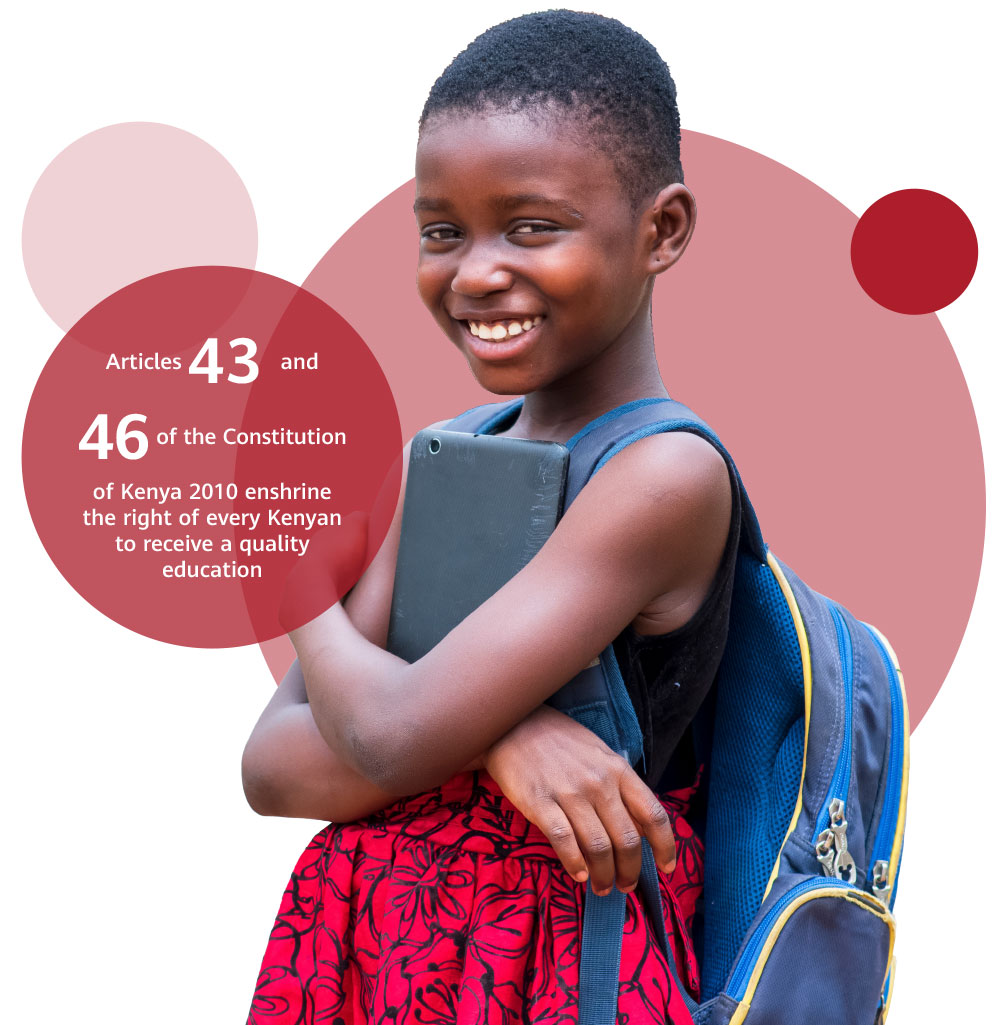
The Digital Literacy Programme
The Republic of Kenya has made a number of national and international commitments to transform our country into a Knowledge Society and Knowledge Economy. Articles 43 and 46 of Constitution of Kenya 2010 enshrine the right of every Kenyan to receive a quality education. And both the economic and social pillars of Vision 2030 recognize the critical need for Kenyan children to receive a quality education that equips them with twenty-first century skills, including digital literacy.
The Digital Literacy Programme (DLP) was launched in 2015 by the Kenyan government as a flagship program under Vision 2030. The main objective of DLP is to enhance the provision of quality education through integrating ICT in teaching, learning, and education management. It also aims to imbue learners with twenty-first century learning skills that will in turn drive future productivity in the economy. Digital literacy is positioned as one of the seven core competencies for learners in basic education under the Kenyan Competency-Based Curriculum.
Running alongside an additional initiative to provide all schools with electricity, phase 1 of DLP has provided almost all public primary schools with a projector, laptops and teacher training for teachers, tablets for students, and devices for learners with special needs. To help stimulate the local manufacturing industry and create jobs, some of the laptops and tablets were assembled in Kenya at two universities. Phase 2 of DLP plans to provide equipment to public primary schools, including programmable output devices that support coding.
DLP also provides each school with a Content Server and Access Point that hosts approved digital content offline, which tablets and laptops can connect to. The content has been created as part of the new Competency-Based Curriculum, which provides digital content for every class – not just IT classes. Internet access was not initially provided during phase 1 of DLP, but the government has set up the online platform Kenya Education Cloud. Additional interactive content has been created and uploaded to the platform and also to other online administrative systems.
The government set up a multi-agency working group that includes representatives from the Ministry of Education, Teachers Service Commission, Kenya Institute of Curriculum Development, Ministry of Energy, Ministry of Industrialization, Ministry of ICT and Innovation, the ICT Authority, and other organizations. This working group has been key to the initiative’s success.
Having so far reached 99.9% of schools with hardware and teacher training, as well as having completed the first four years of digital content, the government is currently starting to provide connectivity to the schools.
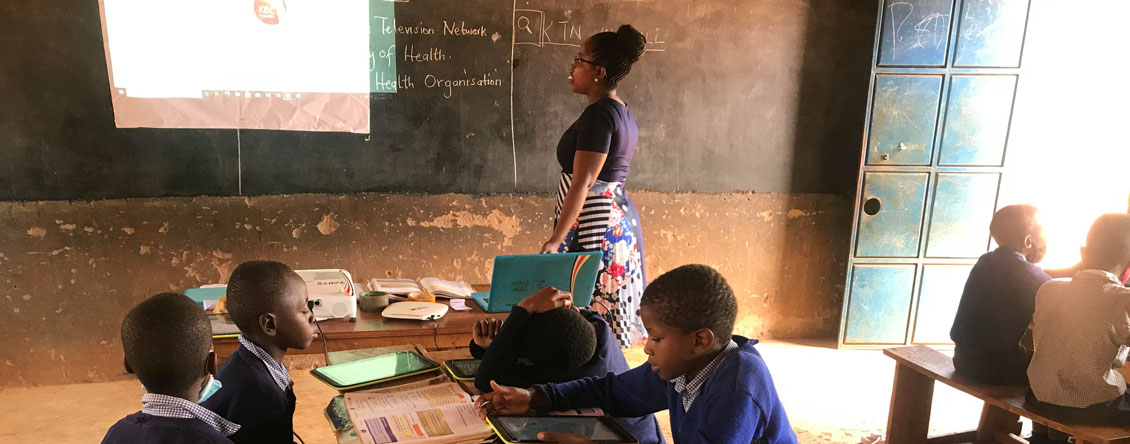
Schoolnet seeks to utilize and extend the 9,000-km National Optical Fiber Backbone Infrastructure (NOFBI).

100Mbit/s
high-speed broadband provided to rural schools
13
rural schools connected to the Internet in 2021Connecting schools to broadband
Schoolnet seeks to utilize and extend the 9,000-km National Optical Fiber Backbone Infrastructure (NOFBI).
Some secondary schools have been connected for five years with support from the Universal Service Fund, while others have been connected through support from donors or domestic funding. In 2021, the government developed schoolnet, a long-term plan to sustainably connect all schools to broadband Internet. This plan seeks to utilize — and extend — the 9,000-km National Optical Fiber Backbone Infrastructure (NOFBI), which the government built and continues to maintain and operate as both a backbone network and a last-mile network for government institutions. This approach has minimized operating costs for broadband, which are met by the ICT Authority – the government agency under the Ministry of ICT that owns and operates NOFBI – as part of its annual budget. This avoids having to pay private Internet service providers on an ongoing basis, which could prove cost-prohibitive.

100
Mbit/s
high-speed broadband provided to rural schools
13
rural schools connected to the Internet in 2021A pilot project began in 2021 with the aim of exploring different solutions to sustainably connect rural schools and provide high-speed broadband at a minimum of 100 Mbit/s. It used either underground fiber or point-to-point microwave technologies to connect 13 schools, focusing on primary schools and nearby secondary schools.
During the selection process, an initial desktop study identified schools that were close to NOFBI leverage existing underground fiber, or which had line-of-sight to make point-to-point microwave viable. A visit to each of the potential schools in the shortlist confirmed the status of their power supply and ICT infrastructure, which in turn helped identify an appropriate connectivity solution. The selection process also considered the commitment and support of school principals and ICT teachers. And, ultimately, it was this latter criteria that guided which schools were prioritized for connectivity – in many cases, they had been using their own budgets to pay for Internet bundles so that teachers could access the Kenya Education Cloud or show online videos in class.
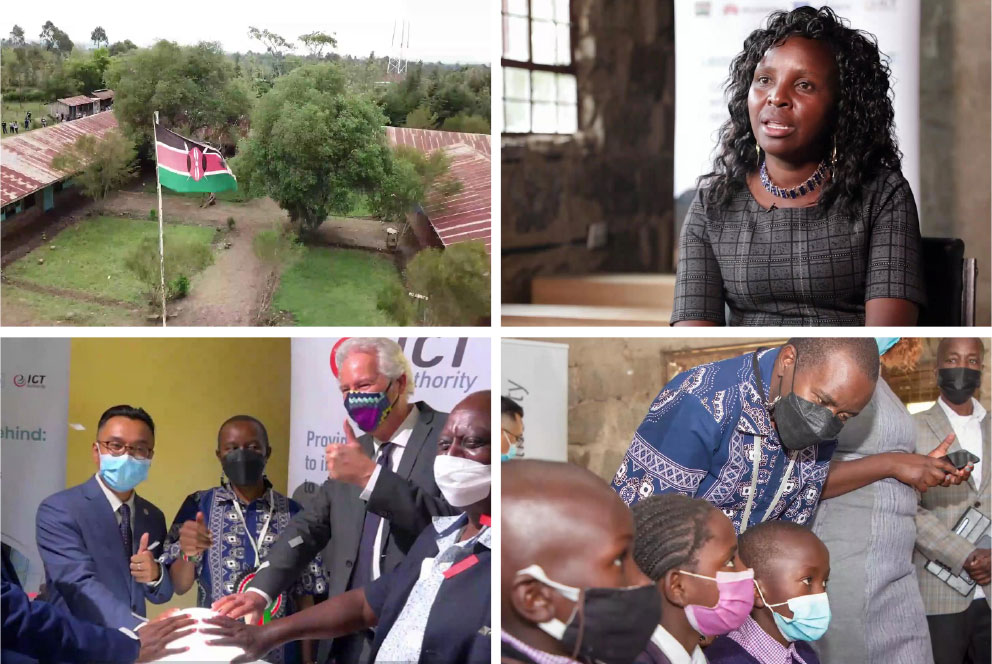
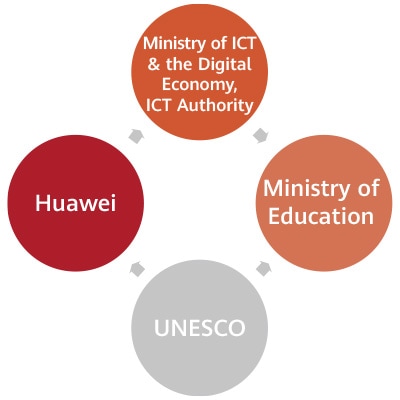
Collaboration on the pilot project
The government runs an existing collaboration mechanism under DLP that enables close collaboration between the Ministry of Education, Ministry of ICT, and the ICT Authority, which is responsible for DLP devices as well as NOFBI infrastructure.
In the pilot project, both Huawei and UNESCO came on board as additional partners.
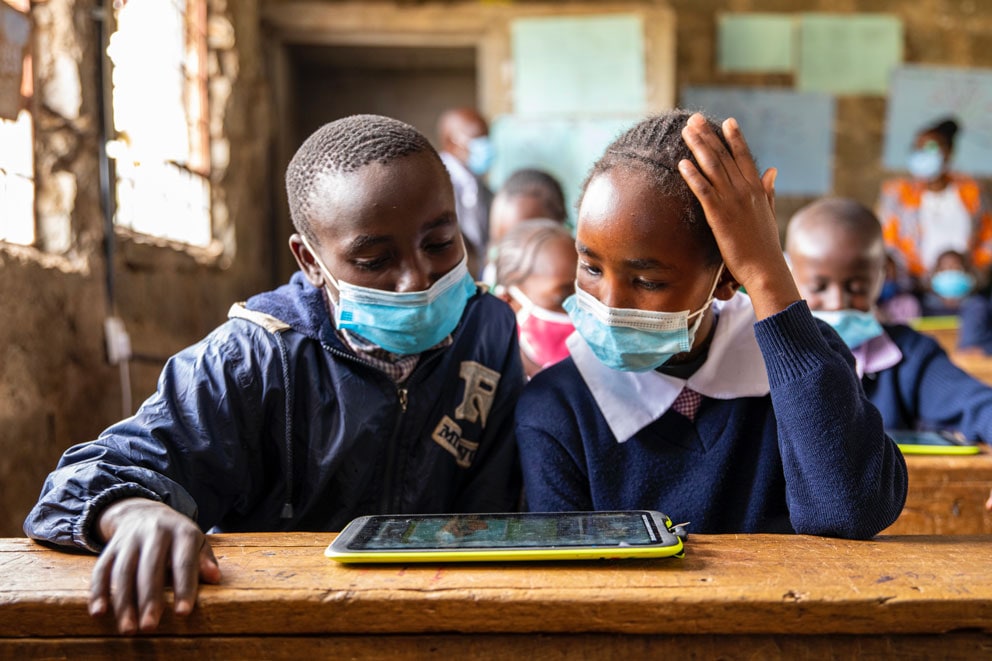

The role of the ministries focused on engaging the relevant government staff and teachers at different levels, while the ICT Authority provided network O&M and technical support to the schools. Huawei performed technical assessments and solution design, provided equipment, and undertook project management and delivery. UNESCO provided support for the school selection process and partner engagement, and advised on monitoring and evaluation.
Local government officials from the Ministry of Education and ICT Authority were closely involved in the project throughout the process, providing on-the-ground support to schools with additional training and technical support. In some cases, ICT officers installed additional Ethernet cables to extend the network from the initial Access Point installed by Huawei to other classrooms, and connected the Content Server and Access Point to the network, thus setting up a second Wi-Fi network and enhancing coverage.

The impact of connectivity on education
The project has been a resounding success.
Students have benefitted with access to learning resources on the Kenya Education Cloud, as well as other resources such as video content and research sites, all of which have helped them improve their digital skills. School teachers and principals have used the online resources now available to develop lesson plans and improve their own digital skills. They have also been able to use the various online administrative systems for key tasks, like school management and parent communication, without having to use their own budgets.
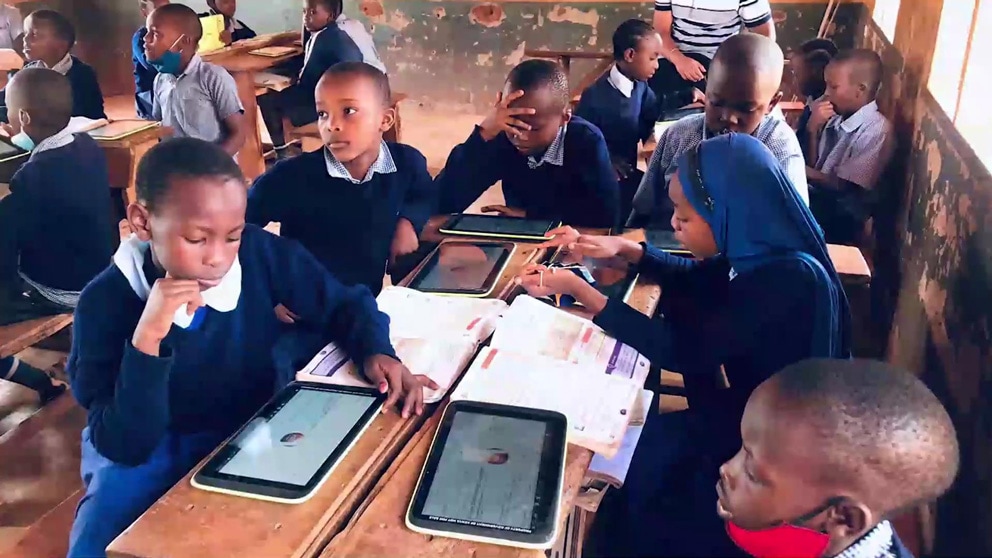
Teachers interviewed about the project have testified to the importance of connectivity and the impact of the project.
“Our learners can only learn well by doing and by seeing. Being in a rural school, we don’t have many things and can only get our knowledge in books, but when they’ve never done something or seen something, it’s abstract in their minds. With the Internet, I’ve been able to show them videos and it’s helped. It’s creating interest among the learners. In our course books, we have links, so for every teaching subject we can get additional materials online, so we can integrate ICT into every learning area in the school. If these learners were left alone, it means they would not be competent enough to go into the world and compete with the other learners who are accessing ICT. Now, as a teacher, I’m so happy because when these learners are accessing the devices from as early as 6 years old, it means that when they finish school, they’ll be as competent as those learners who are advantaged in urban areas. I’m looking forward to producing learners who are competent enough to go into society and the community and get jobs or employ themselves or create jobs for others.”
—Lydia Muchemi, ICT Teacher at Maragima Primary School in Nyeri County.
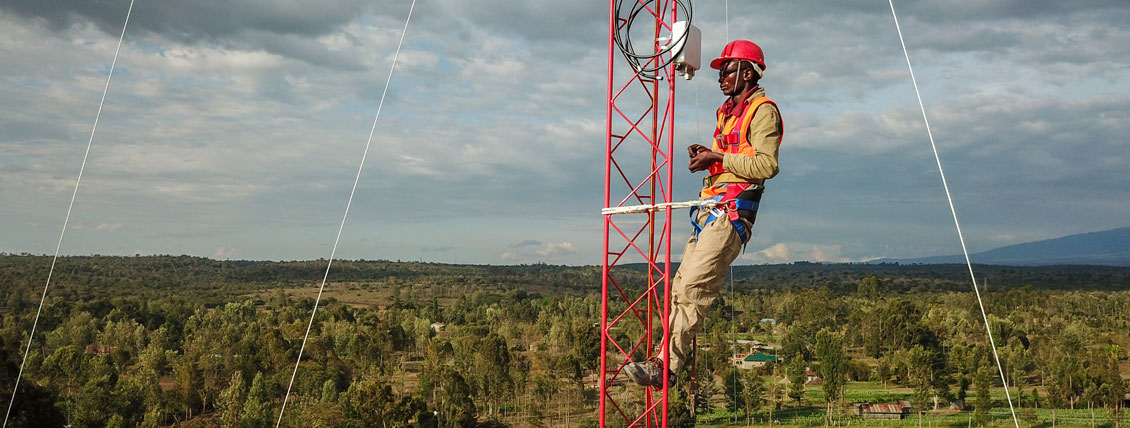
The government is currently working with UNESCO and Huawei to connect more schools as part of DLP phase 2, including schools that cater for learners with special needs such as the hearing-impaired.
Expansion plans
The government is currently working with UNESCO and Huawei to connect more schools as part of DLP phase 2, including schools that cater for learners with special needs such as the hearing-impaired. As part of this phase, video conferencing technology will be provided to further support students with learning challenges.
Phase 2 will primarily connect schools using aerial fiber. In partnership with Kenya Power, the fiber will be deployed on poles that are already installed and supplying electricity to schools. After this, the government will have a clear understanding of which approach works best to connect schools in different locations, which in turn will help it formulate a detailed plan for connecting all schools nationwide.
The Ministry of Education is committed to integrating ICT into education. There is a strong belief that it can play a critical role in enhancing education quality and accessibility, as well as preparing our learners for the future.
We believe that with the right tools, our learners can compete with learners anywhere around the world and enhance the country’s human capital and economic competitiveness.
DigiTruck France
At the Heart of Digital Inclusion in Cities
The digitalization of essential services in France has rapidly accelerated since 2016, underpinned by the goal of taking all public services online by 2022. For French citizens today, digital skills are a must for social and professional integration, training, employment, and enjoying autonomy in daily life.


75%
of today's jobs require digital skills and this figure is constantly increasing
€170
is saved per year per person by using online servicesThe digital gap: A major challenge
Digital technology has become essential for accessing and maintaining employment.
In terms of professional integration, looking for a job is almost impossible without mastering digital tools, given that more than half of all job offers are now posted online and connecting with employers is mostly done by email. Equally, 75% of jobs require digital skills, including low-skilled jobs, and this figure is constantly increasing.

75%
of today's jobs require digital skills and this figure is constantly increasingWhen not mastered, digital technology can result in or accentuate a large number of barriers to social integration, both in terms of access to rights, such as public services, and for everyday use. In fact, 83% of the 250 most used administrative procedures are dematerialized and all procedures will shift online by the end of 2022, an outcome that will mean less human points of contact.
A lack of digital skills may thus become a cause of non-access to rights. Increasingly paperless services are impacting all aspects of daily life, from booking a train ticket and making a medical appointment on the mobile app Doctolib to app-based banking. Online services can save an estimated €170 per year per person in purchasing power and income, and save 30 minutes per process.

€170
is saved per year per person by using online servicesMaking the public autonomous in digital technology therefore means accelerating the entire integration process.
A question of mastery
35% of French people experience at least one form of difficulty that prevents them from fully using digital tools and the Internet. Socioeconomic characteristics, such as education and income levels, have a strong influence on the digital insecurity of a wide variety of people, including young people with little or no education, job seekers, first-generation immigrants, people on social benefits, senior citizens, people with disabilities, and people living in rural areas.
Different responses and support methods must be provided as people face a variety of obstacles, for example, access to equipment and connectivity, lack of skills, a fear or ignorance, illiteracy or language barriers, and accessibility issues due to visual or auditory disabilities. There is not just one digital divide, but several forms of digital divide.
WeTechCare's mission is to make digital technology a factor of social progress. We are an association whose ambition is to make digital technology an opportunity for all by accelerating the social and professional integration of the most vulnerable sections of society. Five years after its launch, WeTechCare has become a key player in the field of digital inclusion in France and Belgium. Through various projects, we lead an ecosystem of 50,000 formal and informal digital caregivers and 12,000 field sites, which have reached more than 560,000 people in need.
Our projects are based on three areas of expertise:
1.Communication
Our objective is to raise awareness of the ecosystem to the challenges of digital inclusion via media channels and by organizing various events throughout the year.
2.Support for the ecosystem
WeTechCare supports local authorities, spanning departments, metropolises, cities, and the operators of essential public and private services. These include CNAV (pensions and contributions), Malakoff Humanis (health, welfare, and retirement services), Pôle Emploi (employment centers), CAF (family allowance funds), and La Banque Postale (The Postal Bank). We also support physical sites, including social centers, PIMMS (social services), local missions, and media libraries. This enables the implementation of digital inclusion strategies as well as the structuring and actualization of digital inclusion plans.
3.Digital projects
Our goal is to activate the community network by empowering volunteers and salaried professionals so that they are able to support vulnerable populations. WeTechCare acts through several projects aimed at different audiences and based on an internally developed platform.
Les Bons Clics
As the first digital inclusion platform in France, Les Bons Clics provides digital caregivers with turnkey resources. The platform is used in more than 12,000 physical sites and by 50,000 caregivers. The platform had also provided training for more than 560,000 people as of 2021.
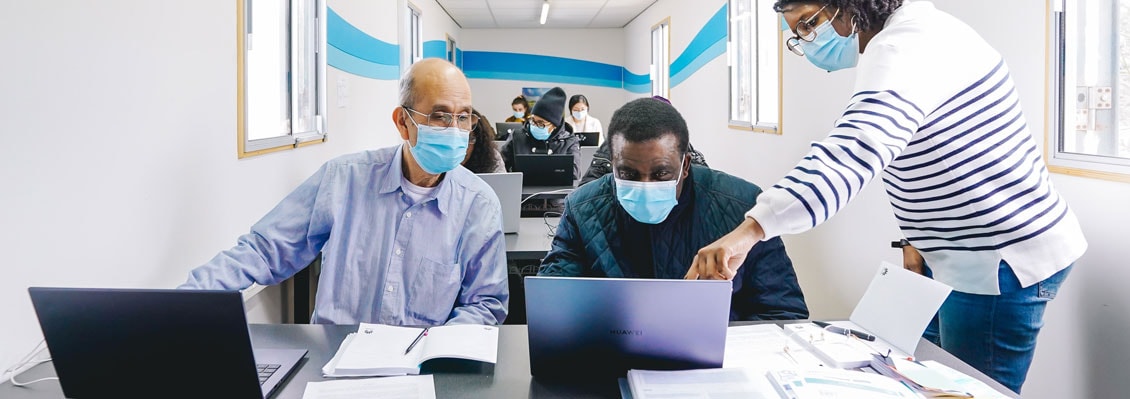
The DigiTruck project: Skills on the move
Since February 2022, WeTechCare has partnered with Huawei France to implement the DigiTruck project.
The project consists of traveling to different cities in France to offer free training in basic digital skills to vulnerable populations in priority neighborhoods. In 2022, the DigiTruck toured nine cities in Ile-de-France and five cities in the south of France, stopping for between two and four weeks in each city.
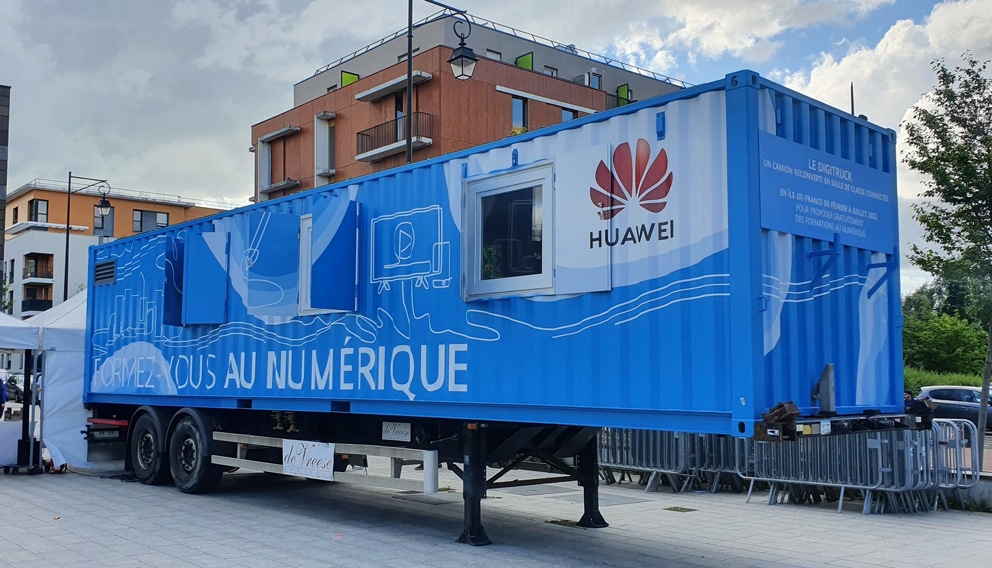 The DigiTruck mobile classroom in France
The DigiTruck mobile classroom in France
WeTechCare's role in this project is threefold. We propose training programs adapted for each city in partnership with local organizations to meet people’s specific needs, including mastering computer basics, creating an email account, understanding online security, and finding jobs online. The training is based on the resources available on our platform, Les Bons Clics, which was built by the educational engineers of our association. With a team of three trainers, we deliver the training from Monday to Saturday in the DigiTruck. Our experienced trainers are receptive to each person who wishes to learn about digital technology, listening to their needs and difficulties and offering them the most appropriate support.
We also collaborate with our partner Huawei and local partners to raise awareness of the project and ensure that the free training benefits the maximum number of people.
A project oriented to people in need
One of the main difficulties encountered in digital inclusion projects is to reach people who, by definition, are not familiar with digital communication methods, and who may be afraid or reluctant to open the door to local support structures. A "go-to" project, such as a mobile classroom like DigiTruck, makes it possible to meet people who are far away from the digital world where they live by breaking down barriers to training.
The location of the DigiTruck is carefully chosen on the advice of city authorities, so it is as close as possible to people who face social and digital insecurity. Converted from a used shipping container by the NGO Close the Gap, the DigiTruck is highly visible and attracts the curiosity of passers by. In fact, we estimate that in the Ile-de-France region, one third of the people trained on the DigiTruck became interested when they walked past it in their neighborhood. The training sessions are free and ‘à la carte’: a person wishing to learn about digital technology can attend a scheduled group course or ask specific questions to the trainers during open sessions. The participants can come back as many times as they want when the truck is in the city, so that real progress can be observed in the long term.
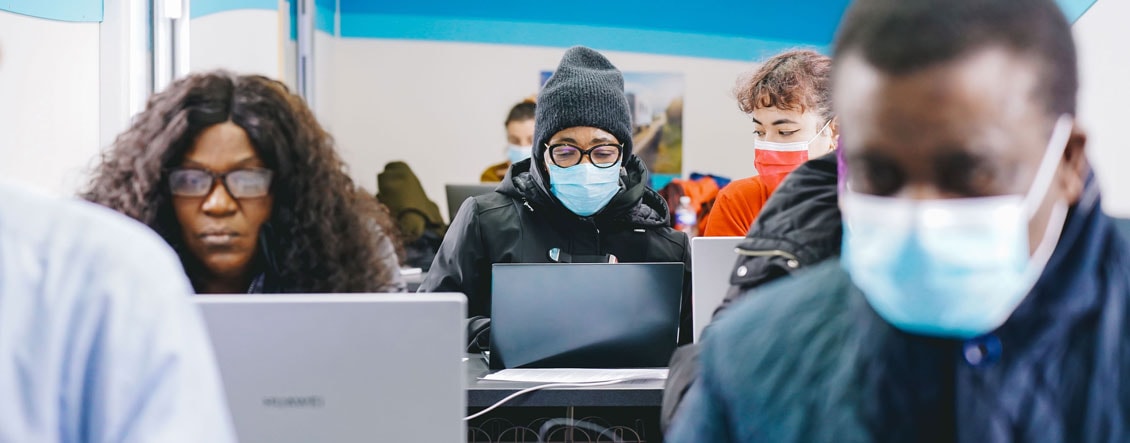
2,100+
people in
14 cities
trained through the DigiTruck project in 2022
The success on the project depends heavily on the synergies created with local parties. By definition, an itinerant digital inclusion project like the DigiTruck is a one-time project that can reach a large number of people in a limited time. However, for the project to be successful and have a long-term impact, it is essential to involve local organizations. This is why the collaboration between Huawei and WeTechCare teams is particularly necessary.
Prior to reaching each city, Huawei's teams are committed to establishing links with local elected officials and learning more about the city's social facilities. The objective of this preparation is to understand the existing support services available in the area so that the DigiTruck can complement and support them. The WeTechCare teams dispatch crews throughout the program to publicize it in community centers, employment centers, community centers, and libraries. The objective of the trainers in the DigiTruck is to get to know the surrounding facilities well, so that they can help direct the public to additional services when the training course is complete.
For example, during the DigiTruck's visit to Massy in Ile-de-France in May 2022, the truck was located near the Place du Numérique, a space set up by the city and operated by MEIF Paris-Saclay, which began offering digital services in September. The DigiTruck was therefore an opportunity to communicate about this place and to direct the trained public to it after the DigiTruck course had finished.
In the DigiTruck, WeTechCare teams also offer workshops for professionals, such as social workers and digital advisors, to give them advice and tools to support their audiences using digital technologies. The objective of the DigiTruck is not only to train people directly, but also to support the development of the skills of local people engaged in support services.
A catalyst for digital inclusion in cities
Thanks to the project, WeTechCare was able to train more than 2,100 people in the Paris region and the South of France, covering fourteen different cities in just nine months. A wide variety of people were able to benefit from the training. Children aged between 6 and 11 were made aware of the opportunities and dangers of the Internet and social networks. Working people aged between 25 and 50 received training on how to search for a job, for example, laying out a CV, learning about the services employment centers can offer, and developing work skills such as using email, word processing tools, Word, and PowerPoint. Senior citizens were able to learn computer basics so they can become more comfortable in performing daily admin tasks, health management, and staying in touch with relatives. The project will continue its journey to other regions in France in 2023.
The training needs of the public are still a major issue. In 2021, the Digital Barometer estimated that 35% of French people had at least one difficulty with digital technology equipment, connection, or skills. The new Barometer scheduled for 2022 will tell us if this percentage is decreasing.
In conclusion, the DigiTruck can greatly accelerate support for the public in a given city over a specific period of time. To have a real impact over time, though, the important thing is to capitalize on this project and raise awareness of the importance of digital inclusion among the city's stakeholders and to support the development of their skills.

Portugal INCoDe.2030:
Smart about Digital Empowerment
Digital skills are crucial for people to fully exercise citizenship and essential for thriving in an increasingly digital society. In Portugal, INCoDe.2030 is an integrated action plan of public policy dedicated to enhancing the digital skills of Portuguese people.

Digital skills are a key element for people to fully exercise citizenship and an important vehicle for meeting the demands of an increasingly digital society.
We live in a globally transformational time that involves everyone, a time when digital empowerment is crucial to achieve social and economic development. As technology evolves and develops rapidly, we must look at people’s needs holistically and work on their skills to make digital technology an ally in promoting an equal and diverse society.
Globally, many challenges with sustainable socioeconomic digital transition exist, but Portugal is taking a frontline approach through training, attracting and retaining talent, and leaving no one behind. The National Digital Competences Initiative e.2030 – Portugal INCoDe.2030 – is an integrated action plan of public policy dedicated to enhancing the digital skills of Portuguese people and positioning our country at the same level as the most advanced European countries in this dimension.
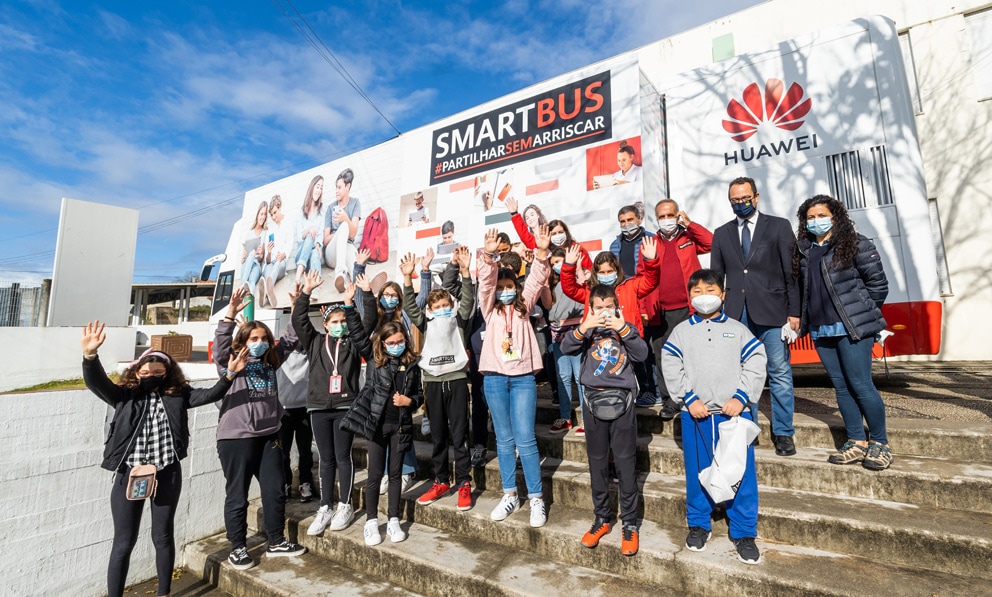 The Portugal INCoDe.2030 action plan is designed to enhance the digital skills of Portuguese people.
The Portugal INCoDe.2030 action plan is designed to enhance the digital skills of Portuguese people.
Digital development starts with digital inclusion and literacy, and is a journey that travels throughout the path of education, from early childhood, through to the qualifications gained at school, and then to graduate specializations that prepare students for advanced digital jobs.
Digital inclusion and literacy create opportunities for all. So, it is essential that young people who encounter digital technologies at an early age gain the necessary skills through appropriate training modalities that enable them to flourish in the labor market. It is in this context that we embarked on Huawei's SmartBus project, traveling from the north of Portugal down to the south to raise children’s awareness about the proper and safe use of ICT through interactive and fun training sessions.
Nevertheless, the digital transition of education is one of the main challenges facing INCoDe.2030. Based on empowering students and teachers through a diverse range of learning methodologies and resources, we aim to ensure that teaching outcomes foster digital literacy and thus inclusion.
Achieving gender equality
One of the key goals of the program is to promote gender equality to attract more women into the digital world. Doing so involves ensuring digital access to content and information and equal access to education, vocational training, employment prospects, and digital skills. To boost women's interest in technology, INCoDe.2030 has collaborated on projects such as Engineers for a Day, I am Digital, Upskill, and the Huawei Seeds for the Future 2.0 Scholarship Program, organizing initiatives that raise women’s awareness of the opportunities and types of work that are available to them.
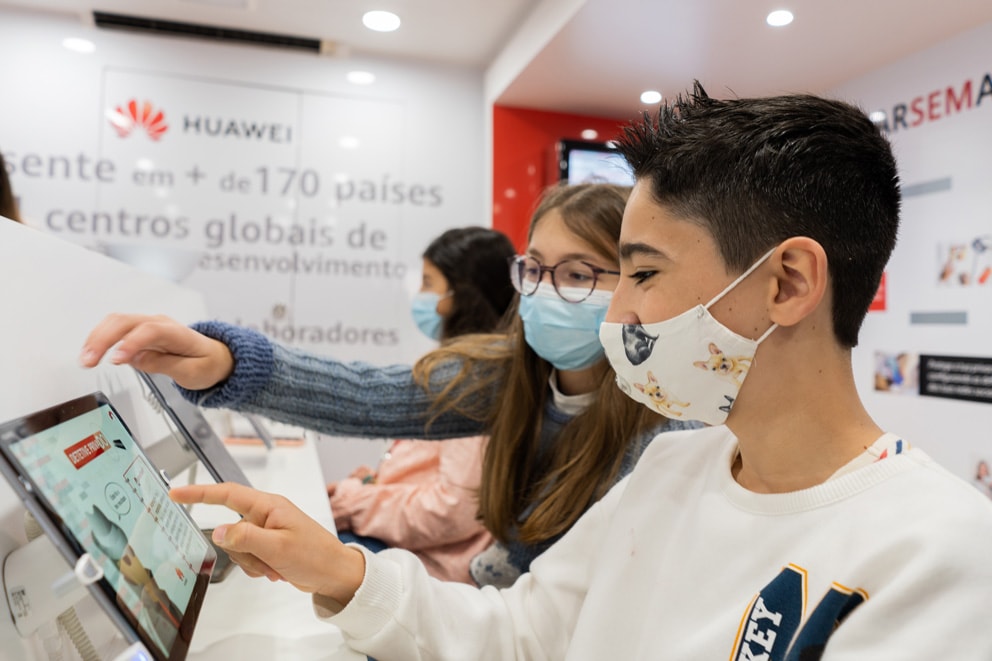 Smartbus training raises children’s awareness about the proper and safe use of ICT through interactive and fun training sessions.
Smartbus training raises children’s awareness about the proper and safe use of ICT through interactive and fun training sessions.
The work domain of technology is traditionally dominated by men. The gender stereotypes that begin in childhood and pervade society tend to steer girls and young women away from studying technology, a trend that is later reflected in the labor market. Given that women possess the same potential in technology as men, the fight against gender stereotypes in the digital domain must start at school and continue through to higher education so that prejudices are deconstructed.
It is also essential to help young women discover their true vocation, as an individual’s calling is not always apparent. And it is important that this acknowledgment starts early, so that the market takes the lead in recognizing ICT vocations as valid, so that women are encouraged to train for technology-based qualifications. The role of companies is therefore decisive in attracting more women to a highly competitive and still male-dominated sector. The acceleration of digitalization has made the need for basic digital skills universal, opening up more opportunities where everyone should have a place.
We cannot allow the new digital age to deepen inequalities. Digital technology must promote equal access for both men and women in terms of employment. And that can only come from a more inclusive, equitable, and diverse society.
A safer online journey
Investing in digital empowerment also promotes the safer use of the Internet and the ability to, for example, anticipate and prevent possible threats or fraud attempts that can irreversibly impact people’s lives.
We know that a lot of work still has to be done to safeguard the youngest and most vulnerable members of society, those who are making their digital debuts and are unaware of the risks. It is a process of both empowerment and risk prevention for citizens and a matter of policies and regulations that can protect citizens, an area in which Europe has made solid progress alongside its digital transformation drive.
The process of sustainable socioeconomic digital transition is a great challenge, but one that Portugal is taking a frontline approach to through training, attracting and retaining talent, and leaving no one behind.
How a Tech Giant and a Small Fishing Village Are Saving a Species from Extinction
In the far north in a small fishing village on the northern tip of Norway, technology and local volunteers have joined forces to fight a potential biodiversity disaster. This is the story of how an unlikely pairing is battling an unwelcome invader.
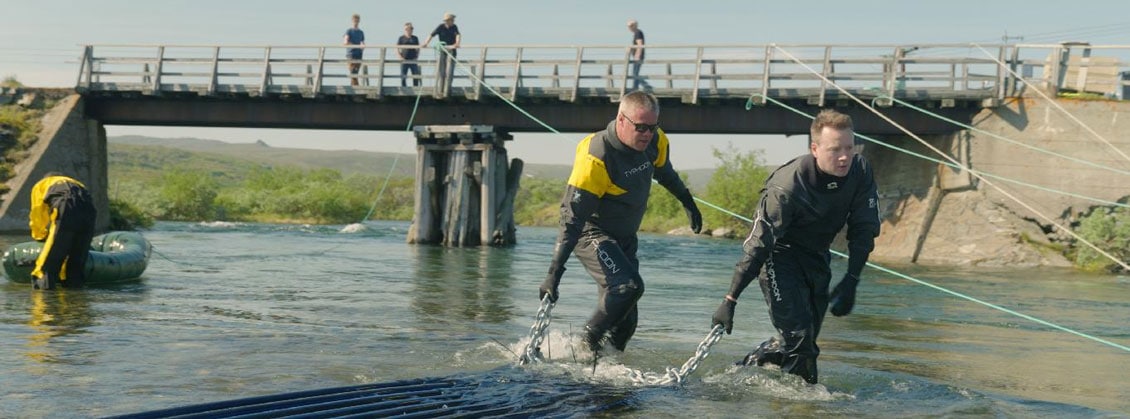
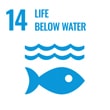
Berlevåg is a place not known to many. With just 1,000 inhabitants, this little society is rarely the center of focus, neither inside nor outside Norway. Early in the 2000s, Berlevåg briefly gained fame in a documentary, courtesy of a charismatic group of local male singers touring the country. After that, little has been seen or heard from the small coastal society.
Located in a distant corner of this large and long country and neighboring the Barents Sea not far from the Arctic, nature can be unpredictable and nasty around Berlevåg. Hostile weather meets the everlasting midnight sun in the summer. In wintertime, you do not see the sun at all for three months while the northern lights dance for the reindeer grazing on the hillsides inhabited by the indigenous Sami people. Berlevåg certainly is a place where nothing and everything coexist. But, as is the case with so many other small fishing villages along the coastline of Norway, it is populated by openminded, enthusiastic, and pleasant people who receive visiting guests warmly and well.
And most importantly they live in harmony with nature.
Nowadays, this otherwise peaceful community is facing the threat of an outside intruder. In the 1960s, the Soviet authorities wanted to expand its fisheries from the eastern side of the country to the west. The solution was the introduction of the pink salmon, also known as the humpback salmon. In contrast to the more commonly known Atlantic salmon, this species in many ways resembles Victor Hugo’s character, the Hunchback of Notre Dame – but the fish variety is a lot less friendly. In the past few years, the number of humpback salmon migrating across the border has been increasing. This is creating challenges for both people and nature.
Indigenous to the Pacific Ocean, the humpback does not naturally belong with Norwegian fauna. Being more aggressive than its Atlantic cousin, the species is now taking over the rivers at a rapid rate. This is creating challenges for Atlantic salmon to reproduce, because they depend on shallow rivers to place eggs. The Atlantic salmon is already on the Norwegian government’s red list of endangered species, and it could face extinction if measures are not put in place.
Fortunately, new technology might save the day.
A solution is born
In March 2021, Berlevåg Jeger-og Fiskerforening (BJFF), a group of local hunters and fishermen, established a partnership with Huawei to protect Atlantic salmon in Storelva, a beautiful river close to the center of Berlevåg. The initial goal was to use an underwater camera and AI to recognize species and count fish, with phase one of the project launched in the summer of 2021.
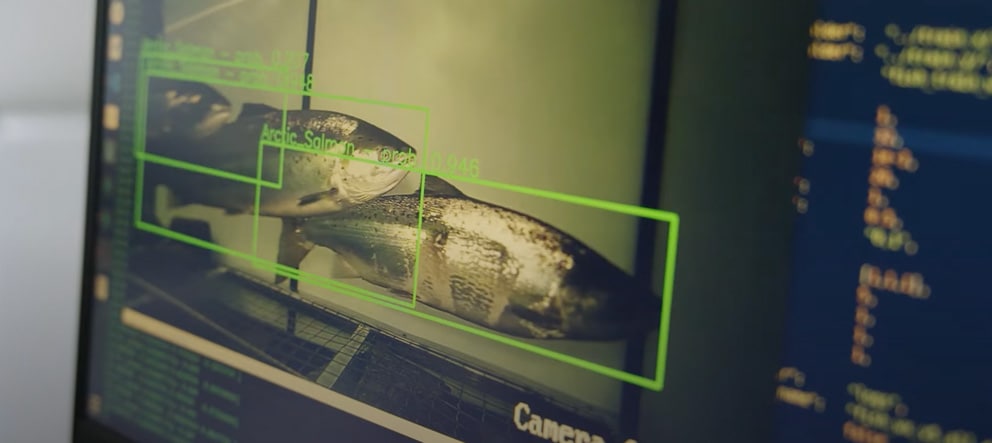
Phase one involved developing an algorithm that would enable the computer system to recognize the river's own stock of salmon and sea char and register the unwanted humpback salmon. This goal was achieved by a good margin. With a continuous video stream from late June to September and tens of thousands of images, the newly developed algorithm was able to identify well over 90% of the Atlantic salmon and humpback salmon that passed through.
Together, we have developed a solution that might save a species from going extinct.
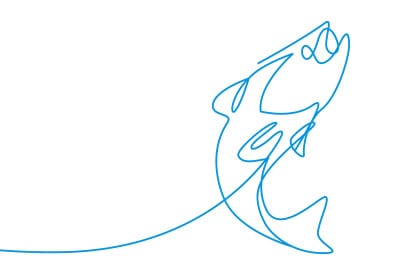
The finished product is implemented
In 2022, phase two of the project started. An updated version of the fish trap was deployed in Storelva with a mechanical open/close mechanism installed to sort the fish that pass through. Local salmon and sea char can pass unhindered, while humpback salmon and farmed salmon are routed into a cage where they can be removed and potentially processed.
By preventing the humpback salmon from swimming up river, the risk of their reproduction is eliminated and the threat to biodiversity eliminated.
Local spirit and a unique collaboration
Alongside BJFF, the other players in this idealistic project are Huawei Norway, Bodø-based Troll Systems, and Oslo-based Simula Consulting. Huawei led the solution architecture design and provided its Ascend computing platform. Troll Systems developed, produced, and led the testing of the installation, while a research group in Simula Consulting developed the artificial intelligence for identifying the humpback salmon.
In June, the first official installation was placed in Storelva. Even though the largest invasion of humpback salmon will not arrive before 2023 – humpback salmon have a two-year breeding cycle – the system has already proven to be effective, catching a few lonely humpbacks passing through. Next year, the stream of intruders will be a lot less lonely, with leading biologists expecting more than 1 million humpbacks to find their way to Norwegian rivers. This will be the real challenge.
For us, the people in Berlevåg, this case truly illustrates the power of real people, with real lives, and real challenges pairing up with a large tech company. Together, we have developed a solution that might save a species from going extinct. We believe in the solution and our hope is now for support in helping us save our rivers from an unwanted intruder that could destroy our local way of life.
Breaking the Silence
Chile’s Guardians Deliver the Message of the Forest
Forest degradation and climate change are creating major challenges to conserving the ecosystem in Chile's Nahuelbuta mountain range, including the endangered Darwin´s fox, which faces the threat of extinction. But now there is hope.
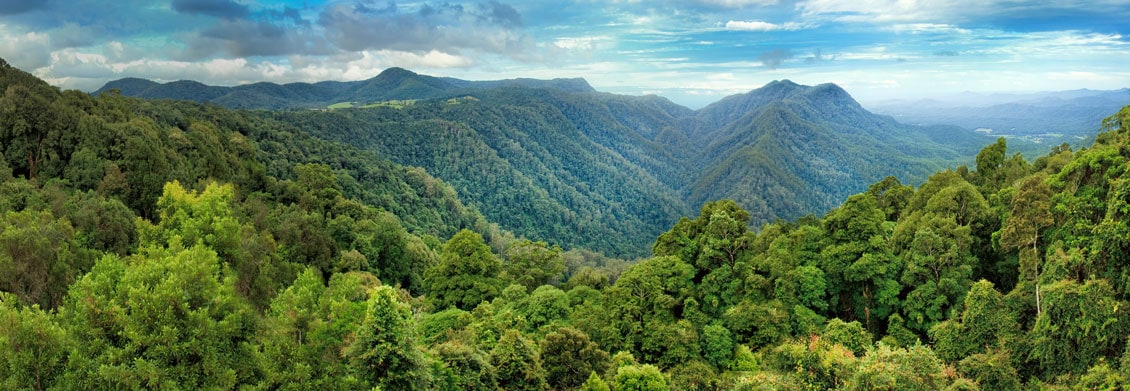


Just 1,000
Darwin's foxes are thought to remain in existenceAs land use continues to change, forest degradation and climate change are creating major challenges to conserving the ecosystem in Chile’s coastal Nahuelbuta mountain range, including the critically endangered Darwin´s fox, with just 1,000 or so thought to remain in existence.

Just 1,000
Darwin's foxes are thought to remain in existenceSo, what should be listening out for? Are there new approaches that would enable us to quickly descramble complex datasets and evaluate ecological integrity and degradation?
Is it possible to monitor, learn, and improve forest conservation management decisions without the continued presence of researchers, forest managers, or ranger teams in the field?
These are the basic questions we asked when developing forest conservation management plans and conducting the research needed for effective decision-making. Travel, equipment, and well-trained personnel costs are high and efficacy is hindered by serious time constraints that impact the monitoring of mid- to long-term biological and biophysical processes in forests.
Unsurprisingly, collaborative and interdisciplinary approaches are required.
The development and application of remote-sensing devices is an area that is growing and increasingly applied to ecological and conservation research.

Assuming that wireless networks are in place, the information recorded by the Nature Guardian system provides insights based on environmental sounds and vocalizations to indicate the overall health of forest ecosystems.

24/7
Data is automatically uploaded to the cloud platformAssuming that wireless networks are in place, the information recorded by the Nature Guardian system provides insights based on environmental sounds and vocalizations to indicate the overall health of forest ecosystems.
An acute need for smart-monitoring solutions

24/7
Data is automatically uploaded to the cloud platformNumerous ecosystems and species, including the critically endangered Darwin´s fox in Chile, are highly sensitive to human activity and require careful planning and the short-term presence of researchers. However, there is a growing need for low-cost, automated solutions that can provide long-term, self-powered smart monitoring capabilities and upload collected data to the cloud through smart devices. Equipment that can record images or vocalizations 24/7 and automatically upload the information to a cloud platform for analysis by AI can provide invaluable data to researchers in labs or forest management teams in the field.

Remote or inhospitable forest ecosystems can greatly benefit from acoustics-monitoring devices deployed in large contiguous areas, like the coastal Nahuelbuta mountain range in central-southern Chile. Achieving the optimal capabilities of devices used to detect environmental sounds and the vocalizations of hard-to-track species poses a major challenge for researchers, given the large combination of complex field parameters such as vegetation, topography, and weather conditions.
The use of remote sensing technologies to study the presence of the elusive Darwin’s Fox in Chile´s southern forests is a fairly recent project inspired by the Nature Guardian solution developed by Rainforest Connection (RFCx). The solution is a solar-powered device fitted with antennas and microphones that can relay information directly to a cloud platform for analysis by AI. These innovative devices have been used in Chile since December 2020, after the Chilean NGO Etica en los Bosques initiated collaboration with RFCx and Huawei to monitor the Darwin’s fox and other species in the Nahuelbuta Mountain range, with Huawei providing the cloud solution.
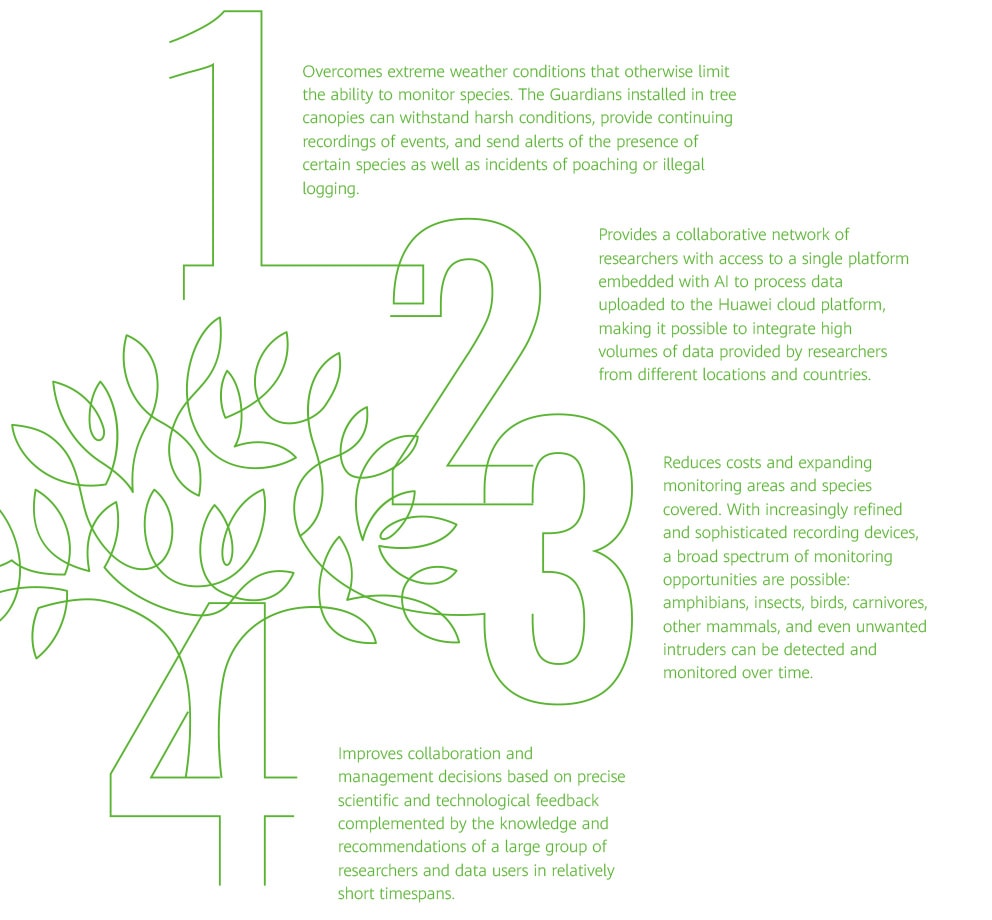
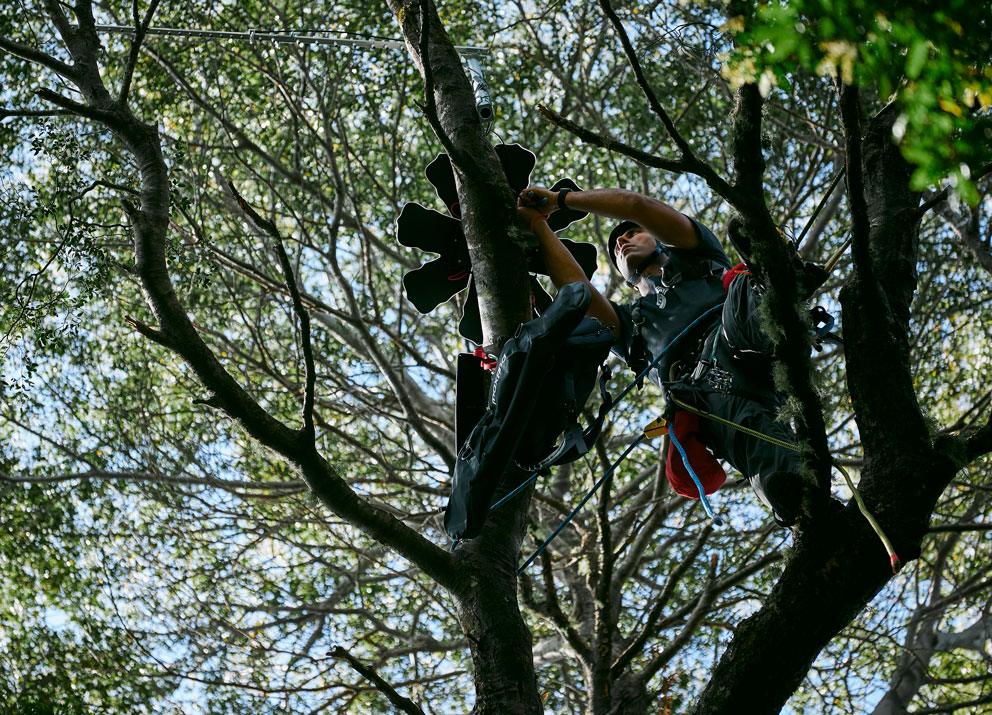 The combination of these advantages can greatly enhance forest conservation and management decisions based on acoustics and remote-sensing technologies, making it affordable and logistically feasible to monitor the health of species’ populations and ecosystems.
The combination of these advantages can greatly enhance forest conservation and management decisions based on acoustics and remote-sensing technologies, making it affordable and logistically feasible to monitor the health of species’ populations and ecosystems.

